Exploring languages and cultures
Use 'Print preview' to check the number of pages and printer settings.
Print functionality varies between browsers.
Printable page generated Saturday, 11 May 2024, 11:01 AM
Exploring languages and cultures
Introduction
Learning a language requires an understanding the cultures of its speakers. This free course, Exploring languages and cultures, explores the multiple relationships between languages and cultures. You will learn about the benefits and challenges of meeting people from different cultures, what it means to be plurilingual and pluricultural, and the ways in which language and human communities shape each other. You also will look at the role of intercultural competence at the workplace, reflect on the use of English as lingua franca in international contexts, and get a flavour of the skills involved in language-related professions such as translation and interpreting.
This OpenLearn course is an adapted extract from the Open University course L161 Exploring languages and cultures.
Learning outcomes
After studying this course you should be able to:
explain what intercultural encounters are and how people can learn from them
discuss how the use of English as a lingua franca is perceived by native and non-native English speakers
illustrate how different groups of people (e.g. professions) develop their own languages and cultures
describe the role of intercultural competence in a business environment
outline the skills and contexts involved in translating and interpreting professions.
1 Intercultural encounters
An intercultural encounter takes place when you become aware that you are interacting with a member of a different community whose ways of thinking are quite distinct from your own. These experiences often occur when you go abroad, but they can take place in any society that has many different cultural groups, such as the UK, for example. During an intercultural encounter, you become aware that you and the other person are operating according to different sets of beliefs and values. This may mean that you are acting in ways that are unfamiliar to each other, which can provoke a sense of unease in one or both participants. But such encounters can offer significant learning opportunities, provided that you use them to think about your own expectations, and to explore the cultural assumptions that appear to be shaping your behaviour and that of the other person (your interlocutor). Reflection of this kind is one of the main ways in which you can acquire what is known as intercultural competence.
In this section you will look at two different encounters and will begin to think about examples drawn from your own experience.
1.1 An encounter in a shop
In the BBC Bakeation series, two celebrity bikers with a passion for travel and cooking, known as the Hairy Bikers, visited several European countries to discover their baking traditions. Hairy Biker Dave studied French at school and worked in Luxembourg for a few months. In the following video he puts his French to the test to buy saucisson lyonnais (a type of sausage).
Activity 1
Watch the video and write your answers to the questions in the boxes below.

Transcript: Dave tries out his French
1 How does the shopkeeper respond to Dave’s efforts to address her in French?
Answer
The shopkeeper consistently replies to Dave in English.
2 Why do you think the shopkeeper answers the way she does, despite the fact that Dave addresses her in French?
Answer
We can only speculate why people like the shopkeeper respond in their own language, but such behaviour is very common. If you are making great efforts to address people in their own language, it can be frustrating to be denied the opportunity of engaging in a two-way conversation in the target language. Here the shopkeeper may be answering in English for a number of reasons:
- She may be trying to be helpful.
- She may be keen to practise her English.
- She may want to appear professional and good at English, able to address customers in their own language.
- She may prefer communication in English rather than in broken French. This does not necessarily imply a negative judgement on Dave’s linguistic ability. She may simply feel that the conversation will be smoother and easier if it is conducted in English.
3 Have you ever found yourself in a similar situation? If so, how did you feel?
Answer
If you have experienced such a situation you may have felt frustrated that the person didn’t respond in the same language, or annoyed about the implication that your use of the foreign language wasn’t very good. Conversely, perhaps you felt thankful that your use of language had obviously been understood.
1.2 A German dinner party
The next intercultural encounter features a British journalist, working in Germany, and his perceptions of a German dinner party.
Dinner parties are a very common type of social occasion and may generate intercultural encounters. The text you are about to read is a personal account of such an encounter. You will probably notice that the author uses two types of argument in his discussion of the experience. The first is argument by analogy, which involves comparing two things in order to highlight a perceived similarity. By its nature, an analogy offers a simplified view of an idea or process – an illustration, rather than a detailed analysis. The second is generalisation, which involves basing general propositions on the observation of particular details. Both are flawed forms of argumentation: analogies invariably break down, while generalisations often prove unsustainable in the face of further evidence. Neither is to be trusted when trying to make sense of other cultures.
Activity 2
Read the article and identify three generalisations and one argument by analogy made by the author.
Reading 1 Frugality rules at German dinner parties

This photograph shows a large saucepan of boiled potatoes.
There has been much talk in Germany about southern European nations being over-reliant on the country’s generosity but when it comes to entertaining, the Germans display quite an appetite for frugality.
When I first came to live in Berlin, I was invited to a dinner party, a media dinner party. A German director and his wife invited me over and I looked forward to it with great anticipation.
Usually dinner parties are not my cup of tea, as it were, but this would be a chance to see how Germans did these things. A correspondent from The Economist had also been invited.
And it was good, very enjoyable – though not nearly as grand a meal as I had anticipated.
The table was laid in the couple’s flat. We chatted a little, anticipation mounting.
And then his wife proudly produced the food – boiled potatoes, boiled green vegetables and ham, boiled ham.
Now I like boiled potatoes, boiled ham, boiled vegetables even.
But it is not what you would have expected in a similar British dinner.
That would have been a feast, produced to the dictates of Delia, Jamie or Heston and probably involving porcini and crème fraiche, the words the English upper-crust use for mushrooms and sour cream.
The point I am making is that the German idea of luxury is different from the British idea.
Germans really are frugal. They like boiled potatoes – and good for them, say I.
You might argue that this was Berlin and Berlin was, of course, partly in East Germany. So Berlin frugality has a different background. And it is true that East Berliners were mocked by ‘Wessies’ when the wall came down because they knew nothing about fancy food.
Just after the two halves of the city were reunited, a West German magazine [Titanic] had a cover story with a picture of an East German housewife. You could tell where she came from because of her awful East German perm. She is holding a cucumber and the caption says: ‘My first banana’.
The point is that bananas were such a luxury that East Germans could not even recognise one.
But the hosts at my dinner party were not ‘Ossies’ but ‘Wessies’, completely au fait with bananas and even, perhaps, porcini.
No, this was just German frugality. You come across it in lots of ways.
I go to a supermarket under a railway arch and it resembles a warehouse, goods stacked to the red-bricked roof with no sense of style or flashy salesmanship.
It is price that matters – even for fancy wines.
This is not a supermarket for poor people. There is wine there at 60 euros (£48/$76) a bottle. But you can bet your bottom euro that it will be cheaper than elsewhere. Even the rich watch the pennies.
Or think of Media Markt, the electronics retailer, which still refuses to take credit cards or even debit cards.
When I presented a card at the check-out, the assistant looked at me like I had offered to pay with a chicken or the use of my body for half an hour. Credit: nein danke.
So as you follow the debate over the euro, and over German resistance to extra spending in Greece, or extra spending in Brussels, bear this frugality in mind. It is seared into the German soul.
[…]
Much is made of the effects of the inflation of 1923, but to my mind that is overblown – a cliché almost.
Far more important are the effects of the World War II, which are less talked about, partly because German suffering became unmentionable because of guilt.
But it was a personal catastrophe for millions of people. Half the homes in Germany were uninhabitable, either destroyed or damaged.
So these are people who experienced great privation, and within living memory. American cigarettes became a currency as people scrabbled for food.
In this city of Berlin, for example, women – Trümmerfrauen (rubble women) – scrabbled through the streets, scavenging in the years after the war. That kind of experience has to inform your attitude to food and material goods.
On top of that, Germans do not actually earn very much compared to those in other European countries – less than in France and Spain and about two-thirds what a comparable British worker has.
And the German wage has barely risen over the past decade. They are frugal because they hold back on pay.
Accordingly, Germans hold their wallets tight to themselves.
Frugal at the dinner table. Frugal too, in the finance ministry.
Note: Delia (Smith) is a TV cook and cookery writer in the UK, and Jamie (Oliver) and Heston (Blumenthal) are ‘celebrity chefs’. Titanic was a satirical magazine, so the cover photo described was obviously a joke. Far from not being able to recognise bananas, after the fall of the Berlin Wall, East Germans used to buy large quantities of bananas in the West to take home.
Answer
Argument by analogy: ‘Frugal at the dinner table. Frugal too, in the finance ministry.’
Generalisations include:
- Germans are frugal.
- British dinner parties are feasts, cooked to the dictates of celebrity chefs.
- The German idea of luxury is different from the British one.
- Germans like boiled potatoes.
- Germans hold on tightly to their wallets.
Activity 3
Read the article again, and answer the following questions.
1 How many dinner parties does the author of this article report on?
Answer
The article seems to be based on only one dinner party.
2 What trait does the author attribute to Germans in general, on the basis of his experience?
Answer
The author generalises that Germans are frugal.
3 What cultural difference between Britain and Germany does he write about, on the basis of this dinner party?
Answer
The author asserts that ‘the German idea of luxury is different from the British idea’.
4 Which historical event does the author suggest contributed to the perceived German frugality?
Answer
He attributes this difference to the widespread poverty and hardship that followed the Second World War.
5 What three examples does the author use to support his conclusions about German frugality?
Answer
The author uses four examples:
- the fact that his local supermarket resembles a warehouse, and puts low prices before ‘flashy’ sales techniques
- the insistence of the Media Markt electronics chain on payment in cash
- the fact that German wages are low.
Activity 4
Think about the following questions, which are designed to help you evaluate the arguments presented in this article.
1 The author concludes his article by drawing an analogy between German culinary preferences and economic practices: ‘Frugal at the dinner table. Frugal too, in the finance ministry’. How robust, in your view, is this analogy?
Discussion
As you saw in the introduction to this activity, analogies always break down. The analogy between German culinary preferences and economic practices does not seem strong. In a country as large and as varied as Germany, food preferences and specialities are often regional and frequently reflect traditions that have been established over centuries. Economic policy is more likely to be a complex and conscious response to the perceived needs of the present moment, which takes into account Germany’s wider responsibility as the leading economic power in the eurozone. The author is basing his observation on just one dinner party, which is a very small sample, and the menu choice could have been down to the hosts’ preferences as an individual couple.
2 Discuss the following statement on the basis of your own experience and supporting your comments with evidence:
‘a similar British dinner … would have been a feast, produced to the dictates of Delia, Jamie or Heston and probably involving porcini and crème fraiche …’
Discussion
The author’s statement refers to three TV personalities, Delia Smith, Jamie Oliver and Heston Blumenthal, each of whom has a distinctly different approach to culinary matters. It is doubtful whether the average British household has the expertise, or the equipment, to cook in Blumenthal’s highly technical way. His mention of porcini and crème fraiche, which are arguably ‘foreign’, fashionable ingredients, coupled with the TV cook name-dropping, implies that the author’s idea of a British dinner party seems much more trend-oriented than the German soirée he attended, and he explicitly contrasts his idea of a British dinner ‘feast’ with the German frugal fare. It could be argued that he is generalising though with both ‘national’ examples, and that the author’s experience of dining out seems restricted to a relatively small segment of the population, both socially and regionally.
1.3 Reflecting on cultural differences
In intercultural encounters we often come across behaviours that would seem odd in our own culture, but there is often a valid reason for such behaviours. It is therefore always worth taking a moment to consider alternative explanations and to remember that, even with an open mind, our own interpretations can be mistaken.
Activity 5
Think of three possible explanations for the frugality of the meal offered to the author by his German hosts.
Discussion
Here are some possible explanations. You may have thought of others.
- The person preparing the meal had limited culinary skills.
- Dietary restrictions meant that the host couple were unable to eat rich or elaborate food.
- The hosts had heard stereotypes about British cooking and thought that their guests would prefer simple fare.
- The hosts had had a busy day and did not have time to shop or cook.
- The hosts did not think the occasion was particularly special.
- His hosts wanted him to try a traditional German meal.
Activity 6
The best way to avoid unhelpful cultural generalisations is to find ways of checking whether your assumptions are correct. Think of three ways in which the author of ‘Frugality rules at German dinner parties’ might have tried to verify his assumptions about ‘German frugality’ before writing this article, without offending his hosts.
Discussion
To check his proposed explanations, the author could have:
- tried to attend other dinner parties
- asked his fellow dinner guest for his or her opinion of the meal they had eaten
- made inquiries at his local supermarket, about the reasons for its layout
- undertaken an experiment: e.g. given frugal or sumptuous dinners to German guests and canvassed their reactions
- surveyed a broad range of German acquaintances about their attitudes to food and finances, rather than generalising on such limited evidence.
1.4 Interview with Professor Byram
You will now listen to an interview with Professor Mike Byram, who has been very influential in the area of intercultural communicative competence in Europe. Working in collaboration with other scholars, as part of a project funded by the Council of Europe, he developed the concept of intercultural encounters.

A head and shoulders photograph of Mike Byram, smiling and wearing glasses, a trimmed grey beard and a suit and tie.
Activity 7
Listen to ‘Interview with Mike Byram’. As you listen, think about the following question and write your answer in the box:
How does Mike Byram define an intercultural encounter?
Transcript: Interview with Mike Byram
Answer
Byram defines an intercultural encounter as a situation in which someone interacts with a person from another social group and where group identity plays a prominent role. This means that different behavioural norms and different sets of values and beliefs are apparent and may be the source of some unease.
Activity 8
a.
Someone from the north-east of England has a meeting with someone from the south.
b.
Two people of different professions interact with each other.
c.
An Argentinian footballer is sent off by an English referee.
d.
A Protestant teacher educator visits trainees in a Catholic school.
e.
An exchange student from China visits the nightclubs of Newcastle upon Tyne.
f.
A British academic visits the USA.
g.
A singer from the USA is interviewed by a reporter from the north of England.
h.
A Romanian visitor spends the night as a guest of the Queen at Buckingham Palace.
The correct answers are a, b, d and f.
Activity 9
In the interview Mike Byram gives four examples of intercultural encounters, each of them illustrating a particular type of difference. The first one he mentions is a British academic visiting the USA. In this case, his example illustrates national differences. What other kinds of differences do the remaining examples illustrate? Use one word to describe each.
1 Someone from the north-east of England has a meeting with someone from the south.
Answer
Regional
2 Two people of different professions interact with each other.
Answer
Professional
3 A Protestant teacher educator visits trainees in a Catholic school.
Answer
Religious
1.5 What about you?
As you have seen, a culture may seem unfamiliar to you for a variety of reasons. Nation and language may be the most visible sources of cultural differences, but there are many more such as religion, gender, profession, or age. Some of these are very obvious, whereas others are more subtle but no less meaningful.
Activity 10
Think about two specific intercultural encounters involving yourself and a person from a context that is different from your own. (They could, for example, be from a different country or different region or differ in terms of occupation, age, sexual orientation or religion.) The encounters should have been significant or unusual, for some reason. One of them should have been unsuccessful or challenging, and the other one successful.
Describe each of them in 100–125 words, explaining what made it significant or unusual and why you think it was successful or unsuccessful. Record your answers in the box below.
Answer
Here are two examples drawn from the experiences of one of the authors of this course as an amateur musician.
An unsuccessful encounter
Some years ago I joined a weekly folk music group in north-east England. Being Spanish, I was hoping to make some English friends and learn some English folk music. Unfortunately, the director insisted on talking to me as though I could barely understand English, perhaps because I had to keep translating guitar chord names from ‘C–D–E’ to ‘do–re–mi’. Despite my best efforts to demonstrate that I was able to give perfectly articulate responses, he would simply fail to notice that I could actually speak English. To make matters worse, other group members did pretty much the same and I never understood why. After a couple of months I just left and found myself a local singing group, where I was finally allowed to hold a normal conversation.
A successful encounter
At the end of a dinner party at home, a few of us started to play the Paraguayan harp. One of my colleagues, who was Korean, fell in love with the instrument and asked me to teach her how to play it. We met every week until I taught her all I knew, which was not much. Eventually she decided that Latin-American music was too alien to her and she switched to the clàrsach (Celtic harp). By then we had become very close friends, so much so that I asked her to be my daughter’s godmother. We visit each other regularly and often end up comparing our experiences as foreign residents in the UK. She is now a proficient harpist; I am not.
The two examples provided above show that not all intercultural encounters necessarily revolve around nationality (British meets Spanish; Spanish meets Korean) as the main source of cultural differences, and show that other aspects of culture are important too.
In the first example, differences in musical traditions and practices were probably just as important as, if not more important than, national or linguistic differences. Once the Spanish musician moved from an instrumental folk group to a singing group in the same town, she no longer experienced communication problems despite the fact that in both cases all the other group members were British. Perhaps something about her behaviour did not meet the unwritten rules for interacting with others in instrumental folk groups, whereas the same behaviour was regarded as normal in a singing group. Another explanation could be that she was more assertive or proficient as a singer than as a folk guitarist, and this competence made the other singers perceive her as more linguistically competent too.
In the second example the encounter may have been successful because the two participants shared an interest in harp music and the relationship developed around one person helping the other.
2 Using a lingua franca
People have been on the move throughout history. In the process, they have encountered other people from different cultures who speak different languages. In order to work with them, to trade with them and, in some cases, to govern them, a language was needed that both sides could communicate in. From repeated encounters between peoples, new forms of language emerged. This course looks at the languages which developed and grew at the meeting points between cultures and peoples.
In this section you look at the history and meanings of the term lingua franca and discover how the use of English as a lingua franca is perceived by native and non-native English speakers working together on an international project.
2.1 The term ‘lingua franca’
The first use of the term ‘lingua franca’ was recorded in 1553. The term franca (literally ‘Frankish’) was at one time used to referred to western Europeans, and lingua franca (meaning ‘language of the Franks or western Europeans’) was an Italian expression for the language that came to be used for communication purposes between traders in the Mediterranean area. Since then, the meaning of the term has evolved.
Activity 11
The Oxford English Dictionary (OED) gives the following meanings for the term ‘lingua franca’:
- A pidgin language drawing its lexicon mainly from the southern Romance languages and formerly used as a trading language, first in the eastern Mediterranean and later throughout much of northern Africa and the Middle East. Frequently with capital initials. Now historical.
- Any language that is used by speakers of different languages as a common medium of communication; a common language.
- In early use sometimes specifically denoting a mixed language that fulfils this role.
- In figurative contexts: a generally understood or commonly used standard, system, or means of non-verbal communication.
The OED also gives a list of examples for each of these uses. Indicate which of the meanings 1 to 4 above each of the examples below illustrates:
a.
1
b.
2
c.
3
d.
4
The correct answer is b.
a.
1
b.
2
c.
3
d.
4
The correct answer is c.
a.
1
b.
2
c.
3
d.
4
The correct answer is d.
a.
1
b.
2
c.
3
d.
4
The correct answer is a.
Activity 12
Now look at these further examples, where the term is used in the plural form. Why do you think the three plurals are different?
- These [native American languages] the missionaries have converted into Lingua Francas.
(1857, Encycl. Brit. XIII. 195/1, cited in Oxford University Press, 2013a)
- A very complex infrastructure of scores of vernacular languages as well as a number of regional lingue franche.
(1971, J. Spencer Eng. Lang. W. Afr. 31, cited in Oxford University Press, 2013a)
- Tribalism, linguae francae and the emerging states
(Samarin, 1961).
Discussion
In these cases different writers have assigned different plural forms to the term ‘lingua franca’ depending on their understanding of which language the term ‘belongs to’ – although given the mixed origins of the original Lingua Franca this is not an easy thing to decide! In the first example, ‘Lingua Francas’, the author is treating the term as English, with a plural ‘-s’ added to the second element. In the second example, ‘lingue franche’, the author is treating the term as Italian, changing the endings of both elements in accordance with Italian grammatical and spelling rules. In the third example the author is treating the term as Latin, this time changing the endings of both elements in accordance with Latin grammatical and spelling rules.
2.2 English as a lingua franca
We now turn to the most successful lingua franca the world has ever seen, certainly in terms of the number of speakers – English.
In the next activity, you will listen to various people who have been working together on a project. Only one of them is a native speaker of English, yet they have used English as their lingua franca throughout the project. In this sense, they are like thousands of project teams throughout the world who, at any one moment, are communicating in English in fields such as science and business.
Activity 13
Listen to Teija, Nadia and Jim talk about their experiences of working together in English. Jim is the only native speaker of the language in the group.
As you listen, make notes about the advantages and disadvantages of using English as a lingua franca from the perspectives of the non-native and native speakers on their project. Type your notes into the appropriate spaces below.
Transcript: Magicc
1
Advantages of using English as a lingua franca on the project:
(a) from the non-native speaker perspective
(b) from the native speaker perspective
2
Disadvantages of using English as a lingua franca on the project:
(a) from the non-native speaker perspective
(b) from the native speaker perspective
Answer
Given that some sort of shared language needs to be used by the participants in this project, the central advantage of English as a lingua franca, from the non-native speaker perspective, is that it is the language of the domains they are discussing. There are, however, three disadvantages mentioned from a non-native viewpoint, disadvantages that could be applicable to any language in which a speaker does not have native-like fluency: it can be tiring, requiring high concentration levels when speaking and listening; there may be a sense of reduced personality in that it is difficult to do justice to one’s ideas or use humour in the same way in a second language; finally, it is time-consuming.
From the native speaker perspective, the principal advantage is that of working in one’s own first language. Nevertheless, there may also be disadvantages: as for the non-native speakers, it may be tiring, due to the high level of concentration required when listening to non-native speakers, and Jim also mentions his feeling of inadequacy and being overawed by others’ linguistic abilities.
The discussion seems to portray the use of English in a rather negative light. Although its practical advantages are acknowledged in passing, the psychological difficulties of operating in a lingua franca are emphasised, along with the physical strain of maintaining the concentration levels required for successful interaction. The next part of the discussion strikes a more upbeat tone.
Activity 14
As you listen to the next conversation, make notes on the liberating and constraining aspects of speaking English as a lingua franca. Then type your answer into the box below.
Transcript: Magicc Project
[interposing voices and laughter]
[laughter]
Answer
Jim talks of how English is no longer the property of British or American native speakers but is being exploited by a variety of different groups and nations. Teija follows this up by mentioning how being able to draw upon the resources of English while also having a first language which others do not understand is a form of liberation. Her words are reminiscent of a vision expressed by Robert Phillipson, a British linguist who sees English as an ‘additive’ resource which speakers can exploit for particular purposes without suffering a ‘subtractive’ effect on their own language (Phillipson, 2009).
However, the drawback of this notion of English as an additive resource is expressed by Nadia who resents the fact that she cannot communicate effectively in her native tongue about her scientific field of expertise. This is because English is the default language of science. If particular fields are predominantly discussed and written about in English, the danger of speakers of other languages experiencing what Phillipson describes as ‘dispossession’ seems to be very real. Jim’s anecdote about the Austrian woman confirms this danger. She suddenly had the sensation of being linguistically dispossessed because exposure to Dutch and English at different stages in her life left her feeling that she had mastery of none of her languages, not even her first language, German.
3 Languages, cultures and communities
Language reflects the groups we belong to. Traces of our class, age, gender, background, profession and pastimes can often be found in the language that we use. As a result, language plays a central role in the identities that we project to the world. In this section you will look at the functions and characteristics of slang and jargon used in different group cultures and subcultures. Every profession also has its own terminology, and you will explore the subtle boundaries between terminology and jargon. The academic world is another context where the appropriate use of language is paramount, and the final part of this section looks at some of the features of academic style.
3.1 Language communities
As well as exploring the relationship between language and the broad categories that people belong to, such as class and age, sociolinguists have in recent years tried to capture the complexity and dynamism of people’s social lives. This has involved investigating the smaller social units they move between, and how their language and behaviour shapes and is shaped by these units. These smaller units have been categorised in various ways. One such category is the ‘community of practice’ (Lave and Wenger, 1991). As the name suggests, such a group comes together around a mutual endeavour of some sort. So, a book club or a church choir can each be described as a community of practice. These smaller groupings can easily form, change and disappear.
Activity 15
Below is a list of leisure activities. In taking up these activities, people often join like-minded individuals and form their own small social communities (clubs). Look at the list and try to decide the gender, age and socioeconomic class of people who you would expect to do these activities, then do the same with two further activities you have come up with yourself. In the box below each activity give a short profile of the most likely type of participant. The first example has been completed for you.
As with any generalising activity, there is the danger of oversimplification. However, it should become clear that the broader social categories of age, gender and socioeconomic class have some influence on the kinds of pastimes people gravitate towards.
Playing squash
Singing in a choir
Ballet dancing
Being part of a book club
Playing football
Doing yoga
Boxing
Other activity 1
Other activity 2
Answer
There are no correct answers to this activity, as this is based on your own perceptions. Below are the responses of one British person living in the UK. Compare them and see where yours are similar or different.
| Activity type | Likely group age, gender, class |
|---|---|
| Playing squash | Young to middle-aged, both sexes but mostly male, middle class |
| Playing bingo | Middle-aged and older people, predominantly female and working class |
| Keeping an allotment | Was traditionally working class but more middle-class people are taking it up; used to be mostly male but that is changing |
| Singing in a choir | Depends on the type of choir: cathedral choirs are often middle class, of all ages, including boy choristers; male voice choirs are typically middle-aged men; gospel choirs are often made up of people of African-Caribbean descent |
| Ballet dancing | Young, female and usually middle class |
| Being part of a book club | Middle class, mostly female |
| Playing football | Was almost exclusively male and working class; now, more females are taking up the game |
| Playing bridge | Middle class and middle-aged; not sure about balance of sexes |
| Doing yoga | Middle class and predominantly female |
| Racing pigeons | Working class, male, generally of the older generation |
| Lawn bowling | Middle-aged and older people, both sexes, working class |
| Boxing | Traditionally, working class and male; however, it has been taken up by more females in recent years, as indicated by the introduction of women’s boxing competitions at the London 2012 Olympics. |
Doing this exercise should highlight how much the smaller communities of practice that people choose to join are, to some degree at least, influenced by their class, age and gender. The fact that some of the activities listed (such as lawn bowling, bridge and bingo) are not international in scope shows that the nation people belong to also influences or limits their choices.
Furthermore, the typical profiles of members might be different depending on the particular context. There are, for instance, various types of choir. A typical church choir may bring to mind white, middle-class and middle-aged singers. However, you only have to think of gospel or Welsh male-voice choirs to dispel the notion that all choir members fit this profile. Remember also that communities of practice are never static and as a result, the profile of a ‘typical’ member is always evolving. For instance, in a growing number of countries, football is no longer the all-male preserve that it once was.
Of course, people can ignore social conventions when deciding which clubs and groups to join. It simply takes more courage to do so. Think for example of the film Billy Elliot (2000), where a working-class boy challenges the norms and expectations of his community in order to become a ballet dancer.
Although there may not be many explicit rules, there are often particular norms of behaviour and, indeed, ways of talking which people need to learn to become part of a community of practice.
Activity 16
Here is a letter written to an archery magazine. As you read it, think about the following questions and make notes in the box below the letter.
- How much of it can you understand?
- Are there words used which you either don’t know or which have different meanings to their everyday ones?
- Why do you think these specialised meanings exist?
Reading 2 ‘Thin’ not always best
I am writing in response to a letter in the spring issue headed Time for change?
I just wanted to say that from personal experience that thinner arrows in fact do more damage to bosses than fatter arrows. During the indoor season I shot both fat arrows (Easton Fatboys) and thin arrows (Easton ACCs) both with a 51 lbs recurve and found that the thinner arrows went through the boss quicker than the fat arrows. Both sets were shot at identical new straw bosses and I found that after shooting two to three Portsmouth rounds the thin arrows were going through the boss, where as it took six to seven Portsmouth rounds before the fat arrows went through.
I have also witnessed similar results under similar conditions by an archer shooting only 28 lbs with both fat and thin arrows. The main reason for this is due to the arrow speed as the fat arrows travel more slowly and will stop more quickly. So if there was to be a change to the line cutter rule to encourage the use of thinner arrows it would, in fact, increase the damage to those expensive bosses.
David Cousins, Lizard Peninsula Bowmen
Discussion
Even if you do not know the language of archery, you might well be able to grasp the general issue which the writer is discussing: the relative merits of using fatter or thinner arrows in terms of the damage they do to the ‘boss’. The meaning of ‘boss’ is not obvious for someone who knows nothing about archery, but the context suggests that it may be the target or a part of it. However, there are sections of the letter that are puzzling to non-archers. What does the ‘51 lbs recurve’ refer to? Does the mention of ‘28 lbs’ also refer to this recurve? What is ‘the line cutter rule’? What are ‘Portsmouth rounds’?
Obviously, some specialist language is needed in order to talk about the particular equipment that is used in archery and the rules of the sport. Archers need to be familiar with the terms of archery, much as a car mechanic has to be familiar with the different parts of an engine and what they are called. However, this practical explanation is only half the story. The use of these terms communicates to the readership of the archery magazine that the writer is part of their community, that he belongs.
3.2 Slang
'Slang’ and ‘jargon’ are terms often used interchangeably because they are both sociolects. In other words, they are both varieties of language used by a particular social group or class. However, while jargon (written or spoken) tends to be terminology associated with certain professions or social activities, slang is more commonly associated with the spoken language, and with social groups whose values and practices differ from, and sometimes antagonise, those of the majority or dominant group in their society. The values, beliefs and practices of such minority/non-dominant groups are sometimes referred to as ‘subcultures’.
In this section you will look at slang from a number of different languages in order to work out what they have in common, especially in terms of their role in relation to the corresponding mainstream cultures.
3.2.1 Cockney rhyming slang
A key social function of the language of a group is that it serves to include some and exclude others. In some cases this constitutes a form of language code which is consciously used so that outsiders do not understand. A famous example of this is Cockney rhyming slang from the East End of London. A Cockney is someone ‘born within the sound of Bow Bells’ – that is, within earshot of the bells of the church of St Mary-le-Bow, Cheapside – but the term ‘Cockney’ is often used more broadly to describe working-class Londoners and their speech.
Rhyming slang probably originated in the first half of the nineteenth century. It works by substituting the word that is meant (e.g. ‘look’) with a common phrase that rhymes with it (e.g. ‘butcher’s hook’). The rhyming word in the new phrase is then omitted (e.g. the word ‘hook’, so ‘look’ becomes ‘butcher’s’: ‘Have a butcher’s at this!’). So, to take another example, if you want to say ‘tie’ in rhyming slang it would be ‘Peckham’ (the full phrase would be ‘Peckham Rye’ – referring to another area of London – with the ‘Rye’ omitted.). It is worth noting here that this only makes sense if you know the geography of the local area.

This is a photo of a Pearly King and a Pearly Queen showing a man and woman whose jackets and hats are decorated with thousands of shiny mother-of-pearl buttons.
Activity 17
Below is some Cockney rhyming slang. See if you can guess the missing elements and type them into the spaces below. The first two have been done for you.
1. Hampstead (Heath) = teeth
2. apples (and pears) = stairs
3. trouble (____ ____) = wife
Answer
trouble (and strife) = wife
4. loaf (____ ____) = head
Answer
loaf (of bread) = head
5. rabbit (____ ____) = talk
Answer
rabbit (and pork) = talk
6. porky (____) = lie
Answer
porky (pie) = lie
7. plates (____ ____) = feet
Answer
plates (of meat) = feet
8. dog (____ ____) = phone
Answer
dog (and bone) = phone
Cockney rhyming slang has spread beyond its geographical origins. It is always evolving and often incorporates contemporary cultural allusions. To take just one example, a lower second-class university degree (2:2) can be referred to as a ‘Desmond’, after the famous South African cleric, Desmond Tutu. Speakers are free to make up their own and often do.
3.2.2 Polari, argot and Lunfardo
You will now listen to three audio clips in which members of the Open University’s Department of Languages talk about slang used in three different cultures: English Polari, Argentinian Lunfardo and French argot.
As you listen, it is worth bearing in mind that the origins of particular varieties of language are never easy to date with any precision, especially as they often evolve from the language environment around them.
Activity 18
Listen to the following audios and try to identify the main similarities and differences between these three sociolects. As you listen you may find it helpful to focus on the following aspects:
- how they originated: who spoke them and why
- how words and expressions are formed
- attitudes of mainstream society/culture towards their use
- present usage.
Transcript: Polari
Transcript: Lunfardo
Transcript: Argot
1 What similarities were you able to identify between Polari, Lunfardo and argot? Make a note of them in the box below.
Answer
- All three evolved, in part, as a secret code for speakers to use as a means of excluding the wider society from their communications. Inevitably, this exclusive function also generated an inclusive one, building a sense of group identity and belonging among users of a particular slang.
- They were (or are) primarily used by marginalised communities, and also often (but not always) related to criminal or covert activity.
- They were (or are) not languages as such because they did not evolve their own syntax. They have, however, forged distinct lexicons.
- Words were (or are) imported from other languages, common words were given new meanings and existing words were transformed by, for example, truncating them and changing the order of the sounds and syllables.
- Initially, mainstream society was either unaware of these slang varieties or regarded them with disdain, reflecting the low regard with which speakers of these varieities were held in the wider community.
- Attitudes towards these slang varieties have changed, in part, because they have featured in the arts and media. One of the indicators of the greater acceptance and even embracing of these varieties is that some of the words have entered common usage. This wider exposure undermined one of the main functions of these varieties, to allow speakers to communicate covertly.
2 What differences did you identify between Polari, Lunfardo and argot? Make a note of them in this box.
Answer
- There are clear differences in the specifics of the three slang varieties – they originated in different places and among different sections of society. Unsurprisingly, they drew their lexicon from different languages.
- The main generalisable difference between them seems to lie in their relative vitality. Polari, for example, has now become an interesting footnote in linguistic history in contrast to argot which continues to evolve. A slang variety’s robustness seems to be related to the degree to which sections of the community that use that variety continue to feel suppressed. So, in the UK, generally more liberal attitudes towards the gay community and a radically altered legal status may have contributed to Polari’s demise. On the other hand, the immigrant communities in the suburbs of French cities still largely feel excluded from the mainstream, which is one reason why French argot continues to evolve.
3.2.3 The purpose of slang
Tom McArthur is the author of numerous works on the English language, including the Concise Oxford Companion to the English Language, from which the following extract is taken.
Reading 3 Why people use slang
The aim of using slang is seldom the exchange of information. More often, slang serves social purposes: to identify members of a group, to change the level of discourse in the direction of informality, to oppose established authority. Sharing and maintaining a constantly changing slang vocabulary aids group solidarity and serves to include and exclude members. Slang is the linguistic equivalent of fashion and serves much the same purpose. Like stylish clothing and modes of popular entertainment, effective slang must be new, appealing, and able to gain acceptance in a group quickly. Nothing is more damaging to status in the group than using old slang. Counterculture or counter-establishment groups often find a common vocabulary unknown outside the group a useful way to keep information secret or mysterious. Slang is typically cultivated among people in society who have little real political power (like adolescents, college students, and enlisted personnel in the military) or who have reason to hide from people in authority what they know or do (like gamblers, drug addicts, and prisoners).
Activity 19
Does McArthur’s account add anything about the forms and functions of slang which are not mentioned by the previous three speakers discussing Polari, Lunfardo and argot?
Answer
McArthur’s account discusses fashion, which was not mentioned by the three speakers you listened to in Activity 18. For a slang to retain its vitality and social purchase, it needs to be continuously evolving. This is true of all language but particularly so of countercultural slangs.
The jargons associated with certain professions and activities, like the varieties of slang featured so far in this section, serve to reinforce a sense of group identity. In the next activity you will listen to an interview in which Nigel White, who teaches intercultural communication skills, discusses his first career, in the City of London’s financial district.

A head and shoulders photograph of Nigel White, smiling and wearing glasses, a trimmed grey beard and an open-necked blue shirt.
Activity 20
Listen to the interview with Nigel White, then answer the questions that follow.
Transcript: Broker culture
1 Write a few words about how Nigel White characterises the language of:
- city brokers
- pharmaceutical workers
- website developers.
Answer
Nigel White characterises the language of city brokers as obscene and aggressive; pharmaceutical workers as far more polite and website developers as ‘different’ in terms of language, tone and speed.
Nigel doesn’t explicitly state how website developers’ language is different in tone and speed, but one would guess that the nature of the job would allow more time for reflection than a city broker’s would, suggesting that the tone and speed are more gentle.
2 The descriptions of Polari, Lunfardo and argot that you heard in Activity 18 focused on their respective origins. What does Nigel White focus on in his description of the language of the different sectors he mentions?
Answer
Nigel’s focus is not on the words used by his fellow workers in the City, with the exception of the swearwords he alludes to. When describing the brokers’ language and that of the other sectors he mentions, he concentrates on their communicative style rather than the specific words they use. This indicates that adopting a group’s mode of communication involves more than merely learning its specialist vocabulary.

This is a photograph of a City trader, on the phone, gesturing dramatically.
In the next part of this section you will look more closely at how language is used in the workplace and at what point specialist terminology becomes jargon.
3.3 Language and profession
The reasons for using words that outsiders may not understand are not necessarily related to a need to keep people in the dark or to assert group identity. In most areas of human activity, the use of specialist vocabulary may be needed in order to refer to specific concepts that everyday language would not be able to express as concisely or accurately. Many professions have developed their own specialist terminology. The glossary that accompanies this course, for example, aims to help you to develop the terminology required in order to talk about linguistic and cultural matters in a more precise way. A professional with good communication skills is aware of the appropriate register to use with each target audience, and adjusts the amount of specialist terminology accordingly.
3.3.1 Same term, different meanings
In the next activity you will watch a video featuring Jan Grothusen, chief executive of an engineering company called Guidance, in which he talks about the potential pitfalls of using particular specialist terms with a member of a different profession.
Activity 21
Watch the video and then complete the drag-and-drop activity that follows.

Transcript: Specialist terminology and jargon
Taking into account what Jan says and your own understanding of the term, match each meaning of the word ‘target’ to the person who would be most likely to use the word with that meaning.
An object that you locate and track
Jan Grothusen
An object that you shoot at
Jan’s customer, who has a military background
A goal
A lay person, using everyday language
Using the following two lists, match each numbered item with the correct letter.
An object that you locate and track
An object that you shoot at
A goal
a.A lay person, using everyday language
b.Jan’s customer, who has a military background
c.Jan Grothusen
- 1 = c
- 2 = b
- 3 = a
Discussion
In its everyday sense, ‘target’ is used metaphorically rather than literally.
As you can see, the connotations of the word ‘target’ are completely different in engineering, military and business contexts. In many instances words which have an everyday meaning also have a specialist meaning in other contexts.
3.3.2 Adapting to your audience
When specialists talk about their field they may tend to use technical language that can only be understood by other specialists. Being aware of your audience’s background and adapting your language accordingly is an important communication skill.
Activity 22

This is a photograph showing a CyScan navigating device on a ship. An oilrig is visible in the background.
Now listen to another Guidance employee, Łukasz Gawryluk, describing the function of one of the company’s products, CyScan, and answer the questions below.

Transcript: CyScan (Part 1)
a.
Lay people with an interest in the company’s activities.
b.
Potential buyers of the product in question.
c.
Engineers who design similar products.
The correct answer is b.
Discussion
The description is probably too technical for people who are not familiar at all with navigation systems. A potential buyer is likely to have a need for such a product and therefore be familiar with the ways in which oil rigs, vessels and ‘DP systems’ relate to each other. An explanation aimed at an engineer would probably contain even more detailed technical specifications.
2 Based on Łukasz’s description of the product, what questions would you ask in order to fully understand what it is used for?
Answer
Here are some questions you could ask about CyScan, though you may have thought of different ones.
- What is its main purpose?
- Where does it measure the range and bearing from?
- What are DP systems?
Note:
A DP (dynamic positioning) system is a computer-controlled means of maintaining a vessel’s position. You might also want to clarify particular terminology in order to check your understanding, e.g. does ‘bearing’ mean direction in this case? Does ‘data string’ mean information?
Activity 23
Listen again to Łukasz and answer the question below.

Transcript: CyScan (Part 2)
a.
Lay people with an interest in the company’s activities.
b.
Potential buyers of the product in question.
c.
Engineers who design similar products.
The correct answer is a.
Discussion
The function of the product is now clearer: it ensures that vessels do not collide with the oil rig. The first explanation shows that terminology is only one challenge for the non-specialist. Technical descriptions often presuppose knowledge which a member of the public does not possess.
3.3.3 Jargon
Every profession has its own terminology, but it is only meant to be used with people who are able to understand it. The use of jargon can be frustrating for those on the outside. Yet, the impulse to have an in-group way of communicating is obviously a strong one, which is why business jargon is always being developed and copied, despite being mocked or despised.

This is a cartoon featuring four people sitting at a table. One is making a long speech, including the words, ‘Considering the fiscal blah blah blah.’ One of the others is asking the person sitting next to him, ‘Did you understand any of that?’ to which the other is replying, ‘Only the blah! blah! bit’. The cartoon is captioned: ‘Does your accountant speak your language?’
Activity 24
In this activity you consider some examples of twenty-first-century ‘business-speak’.
1 The following expressions are often used in the world of commerce and finance. Match the terms to their definitions.
Test it
Run this up the flagpole
The value of something that will be lost by taking an alternative action
Opportunity cost
In future
Going forward
Look in detail
Drill down
Gradually reduce the cost of an asset in the company’s accounts
Amortise
The point at which sales equals costs
Break even
Measure of number of people who visit a venue or retail outlet
Footfall
Clearly a good idea
No-brainer
Talk about something in private
Take this offline
A cut in the market value of an asset, usually enforced by an external authority
Haircut
Using the following two lists, match each numbered item with the correct letter.
Test it
The value of something that will be lost by taking an alternative action
In future
Look in detail
Gradually reduce the cost of an asset in the company’s accounts
The point at which sales equals costs
Measure of number of people who visit a venue or retail outlet
Clearly a good idea
Talk about something in private
A cut in the market value of an asset, usually enforced by an external authority
a.Haircut
b.Amortise
c.Opportunity cost
d.Drill down
e.Footfall
f.Take this offline
g.Break even
h.Going forward
i.No-brainer
j.Run this up the flagpole
- 1 = j
- 2 = c
- 3 = h
- 4 = d
- 5 = b
- 6 = g
- 7 = e
- 8 = i
- 9 = f
- 10 = a
2 Which of these terms would you regard as legitimate business vocabulary and which do you think are unnecessary jargon? What is your rationale for deciding which are legitimate and which are unnecessary?
Answer
There is no correct answer to these questions: one person’s jargon is another’s useful specialised vocabulary. However, it is true to say that many people get irritated by business-speak phrases such as ‘going forward’ and ‘drill down’ because they do not add any meaning to their ‘everyday’ alternatives. On the other hand, take ‘amortise’ or ‘break even’; each succinctly expresses a precise meaning that takes a number of words to convey in non-specialist language and so might more easily be regarded as legitimate. Nevertheless, despite the annoyance that some language can cause, it is worth remembering that people have a natural tendency to create ‘insider’ terms when they come together with members of their family, social group or fellow professionals. This is a means of conveying membership of a particular network of people and, thus, takes us back to the important role of language in the projection of identity.
3.3.4 Features of technical language
Specialist vocabulary is not the only feature of language relating to a particular profession. Other areas of the language, such as its grammatical structures, can be affected by what it is used for and who the audience or readership is, and these are the areas on which you now focus.
Activity 25
Below are two descriptions of what a weather station does. Read them and decide:
1 (without counting) which description is longer in terms of the number of words used
2 which you think is the original description as found in an online encyclopedia (Wikipedia, n.d.).
| Version 1 | Version 2 |
|---|---|
| A weather station is a facility, either on land or sea, with instruments and equipment for observing atmospheric conditions to provide information for weather forecasts and to study the weather and climate. The measurements taken include temperature, barometric pressure, humidity, wind speed, wind direction, and precipitation amounts. Wind measurements are taken as free of other obstructions as possible, while temperature and humidity measurements are kept free from direct solar radiation, or insolation. Manual observations are taken at least once daily, while automated observations are taken at least once an hour. Weather conditions out at sea are taken by ships and buoys, which measure slightly different meteorological quantities such as sea surface, wave height, and wave period. Drifting weather buoys outnumber their moored versions by a significant amount. | A weather station is a place, on land or sea, which has equipment used by scientists to look at atmospheric conditions. This enables them to compile weather forecasts and to study the weather and climate in general. They measure things like how hot it is, how humid it is, how strong the wind is, where it is coming from and how much it rains. They have to make sure that nothing obstructs their equipment when measuring the wind and that no direct solar radiation (insolation) affects their temperature and humidity measurements. They make manual observations at least once a day, while automated ones are taken at least once an hour. Ships and buoys measure weather conditions out at sea and they quantify slightly different things, such as the temperature of the sea surface, how high waves are and how long the waves last. There are far more drifting buoys than there are moored ones. |
Answer
1 Version 2 has more words: 154 as opposed to 127.
2 Version 1 is the original text. It is taken from an entry entitled ‘weather station’ in Wikipedia (n.d.)
Activity 26
Look again at the two descriptions of a weather station and what it does, but focus specifically on the grammatical structures used and decide why one passage contains more words than the other, despite communicating the same volume of information. Make brief notes in the box below.
Answer
Primarily, the second version is longer because it contains more verbs. So, for example, it talks of ‘how much it rains’ (4 words) rather than ‘precipitation amounts’ (2 words). Another way to put this is that the first version is shorter because it contains more nouns (both ‘precipitation’ and ‘amounts’ are nouns).
Measuring the weather involves action on many levels, from the weather itself to the people and instruments doing the measuring. Yet, in Version 1 (above) many of these actions are described grammatically in terms of nouns instead of verbs. This process of turning verbs, adjectives and adverbs, such as ‘how hard the wind blows’ into a noun, ‘wind velocity’, is called nominalisation and is a common feature of scientific and academic writing.
It is noticeable in the original text (Version 1) that when verbs are used they often take a passive construction, for example ‘wind measurements are taken’ rather than ‘people take wind measurements’. You may well have heard it explained that such a construction emphasises the processes (taking measurements) rather than the agents (people). In a sense, when describing how a weather station works it doesn’t matter who takes the measurements. Such a focus also holds true in academic writing in areas of study beyond science (although styles do vary according to the discipline). Concepts and ideas are at the forefront of much academic writing (more so than the people who created them), so passive constructions are used more often than they would be in everyday communication, where the focus is usually on what people say and do.
3.3.5 Rewriting specialist phrases
In this section you will apply some of the features that you have just observed in order to practise basic report-writing techniques.
Activity 27
Imagine that you are working with data obtained from a weather station. You have the following measurements for a particular period:
- Precipitation: 15 mm
- Wind velocity: 20 km/h
- Temperature: 20 °C
1 Write three simple sentences to describe these results, using the verb ‘to be’.
Discussion
- The precipitation was 15 mm.
- The wind velocity was 20 km/h.
- The temperature was 20 °C.
2 Now rewrite the sentences using a verb other than ‘to be’.
Discussion
This is a more difficult exercise. With the first sentence, the verb ‘to rain’ cannot be used with a quantity without sounding strange. You could write something like ‘15 mm of rain fell’, turning the rain into an agent, the thing that does the action.
The second sentence could be reworded as ‘The wind blew at 20 km/h’. Again, the wind is made into a grammatical agent here.
Finally, you might write something like, ‘The temperature stood at 20 °C’.
These transformed sentences describing data sound odd precisely because they turn the weather into something animate rather than an object of study, which is at odds with the scientific context. However, in everyday conversation or in literature, we often describe the weather as if it had a will and character of its own, e.g. ‘The wind was howling through the trees’. The field of science is interested in the effect of one process on another, which requires language to depersonalise such processes by turning them into nouns.
So, particular professions not only use words and phrases that are specific to them but can also assume a particular style of communicating which, in part, is shaped by the purposes for which they use the language. This is one of the challenges that you face when entering the world of academic study. Not only do you have to learn new words and their meanings, but you also have to adopt a new way of communicating.
4 Intercultural competence at work
This section concentrates on issues arising from doing business in different languages and cultures. You will focus on a company called Guidance, a couple of whose employees you met in Section 3. Guidance has a multicultural workforce and operates in diverse markets.
4.1 Introducing Guidance
Guidance is experienced in managing the challenges of working in a multilingual and multicultural environment.
Activity 28
Watch this video in which the Guidance company is introduced by group CEO Jan Grothusen. Select any statements that apply to the company from the list below.

Transcript: Guidance (Part 1)
[cuts to colleagues talking]
a.
the oil industry
b.
the government
c.
ship builders
d.
the food processing sector
The correct answers are a, c and d.
a.
it exports goods to customers overseas
b.
it is based in a multicultural city
c.
it has an office overseas
d.
it imports goods from customers overseas
The correct answers are a, b and c.
a.
it uses recruitment agencies abroad
b.
it has close links with the university sector
c.
it recruits locally
d.
foreign employees recommend contacts and friends
The correct answers are b, c and d.
4.2 Benefits and challenges
You will now hear what the staff have to say about the benefits and challenges of working in a multicultural and multilingual company. You’ll have seen the first part of the video in Activity 28, but this is an extended version, and lasts about 15 minutes.
Activity 29
Watch the next video about Guidance and answer the three questions below by making notes in the boxes.

Transcript: Guidance (Part 2)
[cuts to colleagues talking]
[cuts to colleagues talking]
[cuts to James Grimshaw speaking on the phone]
[cuts to Alessandra Bunel speaking Portuguese on the phone]
[cuts to Portuguese class]
[cuts to Peter Paxton speaking Portuguese on the phone]
[cuts to Peter Paxton speaking Portuguese on the phone]
[cuts to Łukasz Gawryluk speaking Polish]
[cuts to Jan Grothusen speaking German on the phone]
[cuts to Alessandra Bunel speaking Portuguese on the phone]
[cuts to Portuguese class]
1 What benefits of working in a multicultural and multilingual environment do the Guidance staff list?
Answer
Guidance’s staff list the following benefits:
- it encourages ‘multicultural understanding’
- it is interesting to work with people from different backgrounds
- it allows an appreciation of other languages and cultures
- it facilitates the establishment of a rapport with clients in different countries
- it makes it easier to empathise with people from different cultures and see things from a different point of view
- it means that language skills and multicultural experience are prized by employers.
2 What are the differences in cultural working norms that the staff identify?
Answer
Guidance’s staff list the following cultural differences they have encountered:
- that the business culture in the UK is less formal and more flexible than in other countries
- they can use their bosses’ and colleagues’ first names
- that the UK working day starts and ends later than in other countries, but allows for flexible working
- that business meetings in the UK are rarely held over lunch or dinner, and that people in the UK tend not to talk about work outside their set working hours
- different rules with regard to interrupting in meetings
- different cultural practices around the giving and receiving of business cards.
3 What are the company and its staff doing to meet the challenges of doing business internationally?
Answer
Guidance uses ‘service partners’ in the regions where they do business, who understand the cultures and traditions of their clients there and can maintain a positive relationship with them. For cultural, linguistic and networking reasons they have appointed a Brazilian business development manager to tap the market in Brazil. They are sponsoring Portuguese language classes for those employees who will be involved in doing business with Brazil. This has taught them a lot about Brazil and is an important factor in building rapport with Brazilian clients.
4.2.1 A multicultural workforce
In the next activity you listen again to Sharda Bhalsod, a Guidance employee, talking about the advantages of working with colleagues from different backgrounds.
Activity 30
Look at this extract from the video you watched in Activity 29, in which Sharda Bhalsod gives her views about working in a multicultural setting. Then answer the questions below.
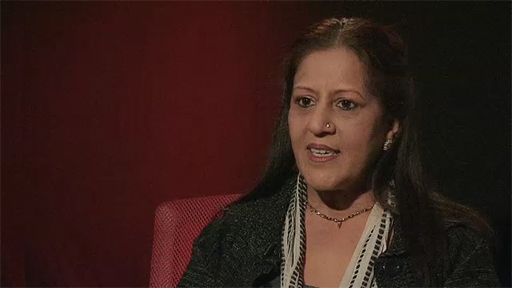
Transcript: Guidance (Part 3)
1. What two reasons explain why Guidance has such a multicultural workforce?
Answer
- It is based in Leicester, which is a multicultural city.
- It recruits its staff internationally.
2. What example does Sharda Bhalsod give when she says that Guidance respects individuals?
Answer
In this particular extract, she refers mostly to the company culture that encourages the celebration of different religious and cultural festivals such as Eid, Diwali, and Polish and Chinese New Year celebrations.
4.3 Doing business in different languages
Having a multilingual workforce and doing business around the world has benefits and also poses challenges. You will now begin to explore the issues arising from the use of different languages in such an environment, through the experiences of some of the people you have met in this section. Section 5 will take the subject of multilingual communication further, as you go on to consider the role of the professional translator and interpreter.
4.3.1 Using interpreters
When doing business with international partners, the lack of a shared language can be an issue. Both of the speakers in the next two videos use the term translation as they describe interpreting jobs. These two skills are often confused, and you will learn more about each of them in Activities 31 and 32.
Activity 31
In this video, Declan O’Dea, sales manager at Guidance’s international marine department, discusses the advantages and disadvantages of using plurilingual staff as interpreters to facilitate communication in international business situations.
Watch the video and complete the sentences below.

Transcript: Interpreting (Part 1)
1. The advantage of using an interpreter is that …
Answer
It enables people to understand what their interlocutor is saying.
2. The disadvantage of this approach is that …
Answer
You rely on somebody else to deliver your sales message and so you lose control of the situation.
3. One way to get around this problem is to make sure you have …
Answer
A basic knowledge of the other language, so that you can at least figure out the gist of what is being said.
Activity 32
You will now watch another account of an experience involving language mediation, this time from the perspective of the person doing the interpreting. Alessandra Bunel is a business development manager who occasionally also acts as an ad-hoc interpreter. Watch the video and answer the question below.

Transcript: Interpreting (Part 2)
In what way do the challenges described by Alessandra Bunel differ from those mentioned by Declan O’Dea in the previous step?
Answer
While Declan O’Dea considered the potential impact of mediation on sales, Alessandra Bunel’s concerns are principally related to safety. She also mentions the added difficulty resulting from the Brazilians’ habit of talking at the same time as each other.
4.3.2 Using a shared language
At the time of writing, English is the default language of international communication, especially in the field of business. When communicating with people with different first languages, native speakers of English need to bear certain considerations in mind.
Activity 33
You will now listen to Nigel White, who you first encountered in Activity 20, when he described his experiences of working as a broker in the City of London. He now specialises in intercultural training for a company called Canning. In this interview, he talks about the responsibilities that speakers have when operating internationally. Listen to the audio clip and answer the questions below.
Transcript: Communication in the business world
Decide if the following statements are true or false.
Nigel recommends that ...
a.
True
b.
False
The correct answer is b.
Discussion
Nigel says that native speakers shouldn’t avoid ‘all colour’ but need to be aware of idiomatic language which non-native speakers might find difficult.
a.
True
b.
False
The correct answer is a.
Discussion
This has the added advantage of allowing more thinking time for the non-native speaker interlocutor.
a.
True
b.
False
The correct answer is a.
Discussion
This is something he mentions. However, it needs to be remembered that not all non-native speaker mistakes come from first-language interference.
a.
True
b.
False
The correct answer is a.
Discussion
Although there is the danger this might get a bit irritating, it is important for smooth communication.
4.4 Doing business in different cultures
So far, the issues that have been discussed in this course have focused primarily on the use of different languages in a business context. However, doing business in international settings is not only about linguistic differences and closing language gaps: cultural differences, something already alluded to by some of the staff at Guidance, can raise just as many issues and are often more difficult to identify and understand.
Activity 34
Watch this video, which is an extract from the one you saw in Activity 29, and features four Guidance staff talking about the differences in cultural expectations and behaviour between the UK and other countries they have worked in. Then answer the questions below.
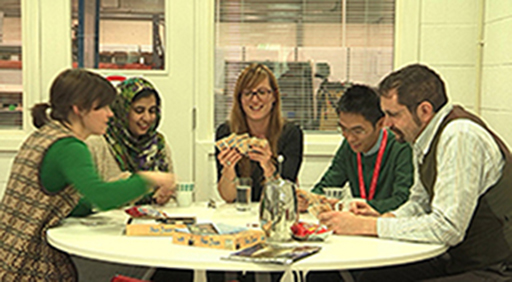
Transcript: Cultural expectations
List the examples of countries and behaviours that they mention, dividing their observations into the following areas.
1. Attitudes to time:
Answer
- In Poland, the working day starts and finishes earlier.
- People have longer working hours in China, and may hold business meetings over lunch or dinner.
2. Attitudes to hierarchy:
Answer
Poland, Pakistan and Italy are more formal than the UK. More formal forms of address for colleagues and bosses are used in all three countries.
3. Attitudes to turn-taking at meetings:
Answer
In Italy it is more acceptable to interrupt each other than in the UK.
4. Attitudes to mixing business and personal life:
Answer
In China it is more common to discuss business outside working hours and to have business meetings over dinner or lunch.
The Guidance employees’ responses show that attitudes and behaviour in different cultures are not always straightforward or predictable. For example, although Italian workplaces are more formal than in the UK in some ways, people are more likely to interrupt each other in meetings.
Remember that supposed characteristics of national behaviour are not absolute and that generalisations of this sort are always potentially risky.
4.4.1 Managing diversity
Diversity is an asset but, as you have just seen in Activity 34, people’s understanding of what constitutes acceptable behaviour at work can differ from one culture to another. So how can staff from different cultures learn to work together?
Activity 35
In this next audio clip, Nigel White discusses recognising differences in any working relationship. He talks specifically from the perspective of someone helping to facilitate a merger between two companies from very different cultural backgrounds. Listen to the audio and complete the task below.
Transcript: Recognising differences
Summarise Nigel White’s key message in one sentence.
Answer
Here is one possible answer:
Recognise differences but try to accommodate to them.
In this section, through the example of Guidance Navigation, you have seen how a company can learn to work in a multicultural and multilingual environment, and how this benefits the organisation in terms of its flexibility and potential to innovate. However, it also means that employees have to learn to accommodate different behaviours and adapt their approaches and language use accordingly.
5 Translation and interpreting
In the previous section you considered how important language skills and intercultural competence are to any working environment where staff or clients speak different languages or have different cultural backgrounds. But there is one particular sector that specifically relies on these skills, namely translating and interpreting. You will now take a closer look at these professions and will see that while the two modalities are very different from each other, they also have much in common.
5.1 What is interpreting about?
Interpreting is the spoken mediation of a message delivered by a speaker of one language to a listener who does not understand that language. Interpreting takes place in a range of contexts (such as daily community life, international conferences, business meetings and courts) using a variety of modalities (such as simultaneous, consecutive, whispering and liaison interpreting). In addition to having an excellent command of both languages, the interpreter must have a number of other professional, technical and interpersonal skills, and must adhere to a strict code of professional ethics.
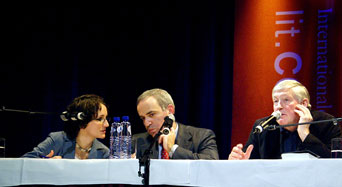
This photo shows the interpreter (left) whispering her interpretation of the speech of the speaker (right) to the listener (centre).
Activity 36
In the following extract from the television series Bakeation, Dave and Si (the ‘Hairy Bikers’) are questioning a Spanish baker about her methods, helped by an ad hoc interpreter who tries to translate a Spanish saying. Despite the Hairy Bikers’ best efforts to understand both parties, they finally resign themselves to the communication breakdown and move on. Watch the video and answer the questions below.
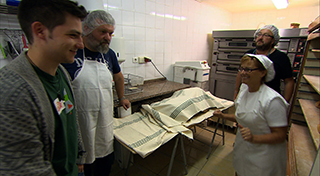
Transcript: The missing word
[whispering]
[Caption: so that its own heat finishes the cooking from within. We must keep the bread covered … ]
[Caption: when it comes out of the oven]
[Caption: because in Asturias we have a saying that goes …]
[Caption: … ‘bread and babies will be cold even in August’.]
1 At which point did the communication breakdown occur?
Answer
The communication breakdown occurred when the interpreter tried (and failed) to translate an idiomatic Spanish saying.
2 What caused the communication breakdown?
Answer
The interpreter clearly omits a word when he says ‘must be keep’. If you speak Spanish, you can see that he should have said, ‘Children and bread must both be kept covered’. Instead, he says ‘must be keep’, which does not make sense in this context.
3 How did Hairy Biker Si try to help?
Answer
By indicating through his behaviour that the interpreter has got his full attention, using words like ‘yes’ and ‘OK’; repeating sentences and trying to guess or supply the missing information.
4 What did Dave and Si do when they finally gave up on trying to understand
Answer
Si puts his arm round the interpreter’s shoulders (a friendly gesture expressing support), and Dave puts an end to an embarrassing situation by moving swiftly on to the next task (a face-saving strategy).
In a friendly environment, people will normally do their best to understand each other by using a range of strategies. However, when a professional interpreter is present, the idea is to allow communication to flow naturally as if both parties were using the same language. A good interpreter is inconspicuous and should be ‘invisible’ in the sense that the two parties feel that they are communicating directly with each other without an intermediary.
5.2 Comparing translating and interpreting

The photograph shows a woman sitting at a desk, talking into a microphone.
The main difference between translating and interpreting is that translation uses the written language whereas interpreting uses the spoken language. While both share many features, the fact that they use different channels (visual versus auditory) results in some important differences.
Activity 37
Before we look at different types of interpreting it is important to understand the similarities and differences between translating and interpreting.
Take a few minutes to reflect on the question:
‘What similarities do you think there might be between translating and interpreting?’
Make notes in the box below on the following:
- the purpose of the translation and interpreting
- the types of language involved
- whether language is the only thing to be mediated or if cultural assumptions, norms, behaviours, etc. are also relevant
- the providers of interpreting and translation services
- the ideal ‘presence’ of the translator/interpreter (should they be invisible or not?).
Discussion
You might have mentioned some of the following similarities between translating and interpreting.
- The purpose of both activities is mediation between speakers of different languages.
- The language involved may be general, involving commonly understood lexis, or highly specialised, using technical or very specific terminology.
- In addition to the language itself, the two activities may also require a degree of cultural mediation.
- Non-professional interpreters and translators are often used as and when the need arises, especially in informal situations. However, translation and interpreting are both well-established professions and there is a wide range of freelance and corporate providers of interpreting and translation services.
- The translator/interpreter should normally aim to be an ‘invisible link’ between the two parties, following a strict ethical code of impartiality. However, in a creative context, such as translating fiction, translators may be more visible as they add their own layer to the work.
5.2.1 Two different professions
Insofar as translation means turning a message from one language into another, translating and interpreting can both be defined as types of translation. However, there are also some differences between the two modalities. While a translator may occasionally act as an interpreter and vice versa, these are two distinct professions with very different demands.
The following extract is a personal account by Sarah Halys, a professional translator, who describes her experiences the first time she was asked to step out of her specialist area and do an interpreting job.
Activity 38
Read the text below. How does what Sarah Halys says modify your understanding of the difference between translation and interpreting (interpretation)?
Reading 4 Translation vs interpretation
Many people don’t realize there’s a difference between ‘translation’ and ‘interpretation’. Even people who work with translators all the time will sometimes ask us, ‘Can you translate at a meeting I’m holding?’ And I’m sure interpreters frequently get handed documents and asked to translate them. Perhaps it’s easier to go from interpretation to translation; I wouldn’t know and wouldn’t like to assume. However, as a professional translator I can definitely say that interpretation is so unlike translation as to be an entirely different proposition and much more difficult for me.
So what is the difference between ‘translation’ and ‘interpretation’? ‘Translation’ refers to the translation from one language to another of something which is frozen in time: a book, a TV show, a letter, a play, a speech someone has already delivered which is recorded and then given to the translator in its entirety. ‘Interpretation’ is a real-time exercise – when you interpret, conversation, speech, etc. is actually taking place, and as it happens you are taking what is said in Language A and communicating it in Language B. It may be that you are interpreting at the same time as others are speaking, or it may be that you wait until the end of a chunk of speech and then interpret it into another language while the speaker pauses to wait for you.
Although many people seem to regard ‘translation’ and ‘interpretation’ as the same or at least activities that the same person would do, and although there are people who do both translate and interpret, the two are radically different both experientially and practically.
Just recently I had my first interpretation gig. I had the honor of interpreting at two Question & Answer panels and two autograph sessions for Mr Yoshitaka Amano at Oni-Con [a Japanese pop culture convention] 2006 in Houston, Texas. I think a large part of the reason why I was approached about the job (about 48 hours before the con[vention] began) was that assumption so many people have that translators interpret and vice versa. However, I took the job and am glad I did so; it was fascinating.
Discussion
The main way in which Halys modifies our understanding of the differences between translation and interpreting is that she sees the former as working with material that is fixed and ‘frozen in time’ and the latter as taking place in ‘real time’. So, the language in a film, despite being spoken, would be translated rather than interpreted into another language, because the translator is able to view and review the language used rather than having to interpret it as it is uttered.
Activity 39
Look at the following questions and in answer to each of them write down the main differences between translation and interpreting. If you cannot answer them all, look up the answers before reading the comment below.
1 What channel is used?
Answer
Translation: Visual (the written word)
Interpreting: Auditory (the spoken word)
2 What is the time span?
Answer
Translation: There is time to think, consult dictionaries, etc.
Interpreting: Happens in real time
3 Is there an opportunity to correct?
Answer
Translation: Yes
Interpreting: No
4 How high are the expectations with regard to accuracy?
Answer
Translation: Very high
Interpreting: Also high, but perfection is not expected
5 What skills are specific to this form of mediation?
Answer
Translation: Accurate, appropriate and clear writing style, spelling, time management to meet deadlines
Interpreting: Face-to-face interaction, memory, pronunciation and oral fluency
6 What is the typical working environment?
Answer
Translation: Desk job, can be done remotely. Now highly reliant on technology (e.g. databases)
Interpreting: Normally on location (conferences, meetings, etc.), with or without specialist equipment
Translators normally work by themselves with a text that is fixed and complete. They can think at length about language choices, look things up, take breaks and revise what they have written. Interpretation, on the other hand, generally takes place in a group of people and the interpreter must interact with these people in real time. This means that whereas a translation can be fine-tuned, the instant turnaround required of an interpreter means that they must go straight to the core meaning of the language to be mediated.
While a translator must be good at writing, possibly in different specific styles, an interpreter must have the ability to speak to people, perhaps from different backgrounds and in different settings. Interpretation may also involve speaking in multiple languages – in other words, within one conversation a Spanish/English interpreter may have to switch between interpreting Spanish-to-English to Person A and English-to-Spanish to Person B. Some translators may also work in both directions but this is highly unusual. Interpretation also poses particular challenges for the concentration, memory and note-taking skills of the interpreter. In simultaneous interpretation they must listen and speak at the same time; in consecutive interpretation, the statement to be interpreted may be long and complex before there is a break to repeat it in the target language. You will learn more about these two kinds of interpreting in the next section.
5.3 Methods of interpreting
Interpreting can itself take many forms, depending on the languages that need to be translated into and from, the number of speakers and listeners involved, the facilities available, the formality of the occasion, and so on.
- In simultaneous interpreting, the interpreter delivers the message in the target language while the speaker continues to speak in the source language without stopping. The simultaneous interpreter usually works in a sound-proofed booth, listening to the speaker through headphones and conveying what is said into the target language through a microphone into the headphones of the listeners.
- In consecutive interpreting, the interpreter speaks after the speaker finishes or pauses their speech. The consecutive interpreter generally sits next to the speaker and takes notes to aid their memory of what has been said.
- Whispered interpreting is essentially simultaneous interpreting but with the interpreter speaking softly into the ear of a listener rather than working in a separate booth with a headset. For practical reasons, whispered interpreting is usually only used in one-to-one meetings.
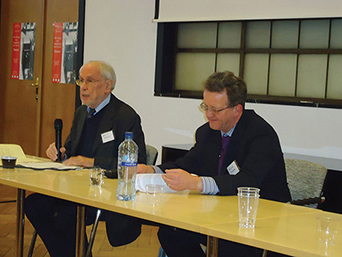
This photo shows two people sitting at a table. The speaker is looking at his notes while the interpreter relays what has just been said.
- When there are a large number of source and target languages involved (for example, in major international conferences), it may not be possible to find interpreters for all possible language combinations. In such cases a method known as relay interpreting may be used. It consists of getting an interpreter competent in the relevant source language to interpret into a language common to all of the other interpreters present, so that each of them can then render the message into their own target language. For example, a message in Swahili might first be rendered into English and then into a number of other target languages.
- In conversational situations, a single interpreter may be used as the only mediator through the entire conversation, alternating languages as different speakers take their turn. This is known as liaison interpreting. It is a highly demanding modality due to the constant language switches involved.
- Sight interpreting is a peculiar mixture of interpreting and translation, where the interpreter relays in speech the content of a written document to one or more listeners. It is sometimes used in legal or medical contexts, where previously unseen documents may become available during the proceedings.
- Remote interpreting, where the interpreter is not physically present in the same location as the speakers and listeners, has become another option since the arrival of technological advances such as video conferencing. This is especially useful when an interpreter is needed at short notice and/or there are few local interpreters available.
As you can see, there are a number of different forms of interpreting, but the mechanics are only one of the elements that differentiate one form from another. To gain a better understanding of interpreting professions, it is essential to consider the social contexts in which interpreting is performed.
5.4 The contexts of interpreting
Interpreting may be used in any situation where people who do not speak each other’s language need to communicate with each other. Such situations are a common occurrence in a variety of social contexts. Some of these contexts involve very specific communication needs and constraints, therefore a variety of specialist areas have emerged in the interpreting profession. Settings may include community, conference, business and court interpreting. Here you will look at court interpreting.
5.4.1 Who is entitled to a court interpreter?
Under the legal system of England and Wales, everyone should have equal access to justice. (This is, of course, also true of Scotland and Northern Ireland, but since they have distinct legal systems, the following examples refer only to England and Wales.) Access to an interpreting service is therefore necessary to ensure fairness and equality where a defendant, litigant or witness cannot speak or understand English or is subject to another linguistic challenge such as deafness or hearing impairment. But who should be responsible for providing this service and who should pay for it?
Activity 40
a.
Only a professional interpreter should be used.
b.
Non-registered interpreters should be approved by the judge.
c.
A D/deaf person should be free to choose any interpreter they like
The correct answer is b.
Discussion
If a person who is D/deaf or has a hearing impairment wishes an unqualified friend or relative to interpret for them, they must first ask permission from the judge. If the judge is not satisfied that the person has the necessary competence, then the court will arrange and pay for an interpreter.
a.
The defendant should find a friend or relative who can act as an interpreter.
b.
The court should provide an interpreter, but the defendant should pay for the service if they can afford it.
c.
The court should provide an interpreter free of charge, regardless of the defendant’s financial situation.
The correct answer is c.
Discussion
The court will ensure that anyone attending a committal case (i.e. where the defendant has been charged with a serious offence) has the free assistance of an interpreter if they cannot understand or speak English.
a.
The defendant should find a friend or relative who can act as an interpreter.
b.
The court should provide an interpreter, but the defendant should pay for the service if they can afford it.
c.
The court should provide an interpreter free of charge, regardless of the defendant’s financial situation.
The correct answer is b.
Discussion
The court will only provide an interpreter for non-committal (i.e. less serious cases) if the defendant cannot afford to privately pay for an interpreter and has no family member or friend who can interpret for them.
a.
Bilingual Welsh speakers should either speak in English or pay an interpreter themselves.
b.
The court should provide an interpreter free of charge so long as the trial is held in Wales.
c.
The court should provide an interpreter free of charge anywhere in the UK.
The correct answer is b.
Discussion
Any party has the right to speak Welsh in legal proceedings in Wales, so the court will arrange and pay for an interpreter for non-Welsh speakers if the case is being heard in Wales. This does not apply to other areas of the UK.
Discussion
The answers here detail the situation under the legal system of England and Wales in 2014. Whether you agree that this is fair and appropriate will obviously depend on your personal point of view. You may feel that in scenario 1 the judge might not be qualified to make this decision about linguistic competence, and that in scenario 3 the principle of equality before the law is compromised because access to a qualified interpreter depends on the defendant’s family situation.
5.4.2 Remaining impartial

The photo shows the imposing façade of the central law courts in Caen, France.
You might have noticed from personal experience or from watching courtroom dramas on television, for example, that the behaviour of witnesses may affect their credibility in the eyes of the jury, and this also extends to their language. Where a testimony is mediated by an interpreter, this could have potentially serious consequences for fairness and equality. In a research paper published in 1996, Gibbons and Grabau considered how the conduct of a court interpreter might influence the legal process. As might be expected of a legal journal, the language in this extract is quite complex.
Reading 5 Colouring the interpretation
Legal literature is replete with instances in which a misinterpretation affected the substantive rights of parties, and linguists have discovered what attorneys [lawyers] naturally know – that the manner and demeanor of a witness affects credibility. For example, a defendant testifying using complete sentences is more likely to be acquitted than a defendant testifying in sentence fragments. However, many judges and attorneys are not aware of the impact that even minor alterations by an interpreter may have on a juror. Even minor differences such as dialect, accent, voice quality, and linguistic fluency are related to how a listener views the speaker’s trustworthiness, ‘likability’, and benevolence. Accordingly, interpreters may subtly, even unconsciously, affect the outcome of the proceedings through their interpretation strategy. This section discusses six ways a court interpreter may ‘color’ the interpretation and affect how a juror evaluates a witness or attorney in four areas: convincingness, competence, intelligence, and trustworthiness. These four areas are essential in making a credibility determination.
Gibbons and Grabau based their discussion on an experiment investigating how the English-language interpretation of testimonies given in Spanish influenced the perception of the credibility of witnesses in the eyes of mock jurors. Interpreters will often use a polite form of address even if such was not used in the original. An example of this is the witness saying ‘No’, and the interpreter saying ‘No, sir’. Research suggested that jurors viewed witnesses who used terms like ‘sir’, ‘ma’am’ or ‘miss’ relatively more favourably. Other interpreters rendered the Spanish testimony of witnesses into a more formal style of English than was the case in the original Spanish. These witnesses were evaluated more favourably than those whose testimony was interpreted in a less formal style. On the other hand, witnesses whose testimony was interpreted in the passive voice were generally evaluated as less intelligent or trustworthy than those whose utterances in Spanish were interpreted in the active voice. ‘Hedging’ (avoiding making a definite statement) and the use of words like ‘well’ were considered to indicate uncertainty in a witness, so the addition or deletion of such words by the interpreter could affect the perceived credibility of a witness.
Gibbons and Grabau concluded that:
Existing research demonstrates even minor errors in interpretation may affect how a factfinder views a witness. Accordingly, judges, attorneys, and interpreters must be constantly vigilant that at all times the interpreter is interpreting everything that is said in the appropriated grammatical form and register. Moreover, the ‘visibility’ of the interpreter in the courtroom may affect how the jury views the counsel, the witness, and possibly, the court itself. This research further supports the need for professional certified court interpreters because most of the problems discussed above can be eliminated or minimized through proper court interpreter training.
5.4.3 Accuracy versus effectiveness
Court interpreters face further challenges, such as when court personnel use language whose literal translation may be confusing to a witness, or when a witness makes a slip of the tongue, the literal translation of which could create confusion. Court rules require that interpreters should translate exactly what has been said, preserving the original linguistic register, and should not address questions directly to witnesses to request clarification. But what if following these rules to the letter creates obstacles to communication? Can court rules come into conflict with the need for interpreting to be fair and equitable?
Activity 41
Look at the following four examples of court interpretation.
(a)
Witness: Ahora, si yo no me tomé ningún acto de echarla, porque yo le prometí que no la iba a echar. (Now, if I didn’t take any act to throw her out, because I promised her that I wouldn’t throw her out.)
Interpreter: And also I had promised her that I wouldn’t evict her.
(b)
Solicitor: And you are the defendant before the court?
Interpreter: ¿Y usted es el que está aquí en la corte? (And you are the one who is here in court?)
(c)
Witness: (in German): Some said they would not travel to Israel.
Interpreter: … to Germany; witness says Israel but it must be Germany.
(d)
Witness: No.
Interpreter: No, sir.
1 What strategy is being followed by the interpreter in each case? Match each example with the relevant strategy.
Formalising common expressions
Example (a)
Simplifying complex expressions
Example (b)
Correcting an error in the original
Example (c)
Adding politeness
Example (d)
Using the following two lists, match each numbered item with the correct letter.
Formalising common expressions
Simplifying complex expressions
Correcting an error in the original
Adding politeness
a.Example (a)
b.Example (b)
c.Example (c)
d.Example (d)
- 1 = a
- 2 = b
- 3 = c
- 4 = d
2 Now look at the examples again. Do you think the interpreter was doing a good job?
Discussion
You might argue that the interpreter was doing a good job in all four cases. In examples (a) and (d), the interpreter rendered the witness’s language into a form that would be more appropriate to a courtroom setting. In example (b), the solicitor’s legal jargon was made more accessible to the defendant and thereby helped the court’s proceedings. In example (c), confusion was avoided by the interpreter’s clarification.
You might be interested to know that examples (a), (b) and (d) could all be subject to the criticism that the interpreter did not translate exactly what had been said and that in examples (a) and (d) a false impression was created with regard to the witness’s status and/or personality. In example (c), the interpreter’s correction of the witness’s slip of the tongue caused the court’s disapproval and reprimand since the speaker’s intention was presumed and his words altered.
These examples and the research reported by Gibbons and Grabau (1996) show that the performance of an interpreter may affect how the jury views what happens in court. The researchers conclude that, just as the appearance and behaviour of a witness affects their credibility in court, the performance of an interpreter as they relay the words of a witness may influence how the witness is perceived by the jury in the areas of convincingness, competence, intelligence and trustworthiness, all of which are important to their overall credibility. Therefore, it is essential to have qualified, trained interpreters in court. You will look at the skills required for interpreting in the next section.
5.5 Computers and translation
Translating requires knowledge of both language and culture, as well as problem-solving skills and creativity. A professional translator who has mastered these skills is always better suited to the job than a machine. However, there are aspects of translation that a computer can handle very well, so that human and computer together make an excellent team. In this section you will find out more about the role of computers in translation, and will consider the differences between machine translation and computer-aided translation.
Computer-assisted translation is where professional translators use computers to help them access, develop and search terminology databases, where words and phrases can be entered along with the users’ own translations, sometimes as well as additional contextual information. This method can be time-consuming in the beginning, but can save time in the long run, particularly for specialised translation. A legal translator, for example, may spend hours translating one short piece of text because it contains phrases that need checking against the respective legal systems. Professional translation software will help them to easily reapply this work where appropriate at a later stage.
5.5.1 The back-translation test
There are many translation tools freely available online. You may already be familiar with Google Translate, for example. In the next few activities you will apply a simple technique to compare its performance in different languages.
The English text (Text 1) below has been put through an online translation tool to translate it into French and Urdu, and then both translations were retranslated back into English. This procedure is known as back-translation.
Activity 42
Compare each of the two back-translations (Text 2 and Text 3) with the original English version of the text (Text 1).
Text 1 (original English version)
Game combats campus culture shock
A computer game has been devised to help overseas students deal with the culture shocks of university life in Britain, like seeing kissing in public.
Players of C-Shock have to complete a series of tasks a foreign student might face on their first day at university. They include seeing people drinking alcohol and smoking, in a 3D recreation of the University of Portsmouth campus.
One of its devisers, academic Nipan Maniar, said he hoped the game would help students know what to expect. ‘We thought we could devise a game that they could play on their mobile phone on the way here so they would know what to expect’.
The senior lecturer in the university’s faculty of creative and cultural industries, who is Indian, said he experienced a ‘massive culture shock’ himself when he came to Portsmouth in 2000 to do his MSc. ‘It was not just the environment I was in, but the teaching – the relationship with tutors was very informal.’ And many students from places like South Asia were often shocked to see women smoking, drinking and being friendly with the opposite sex, he said. […]
He said online games could be a powerful tool in helping international students acclimatise to life on a UK campus, as long as they are not solely about imposing a stereotype of campus life.
Text 2 (translated back from French)
Fighting game culture shock campus
A computer game designed to help students abroad to shocks culture of university life in Britain, like seeing kissing in public.
The C -Shock players must complete a series of tasks a foreign student can face their first day at university. They include seeing people drinking alcohol and smoking in a 3D reconstruction of the University of Portsmouth campus.
One of his devisers, university Nipan Maniar, said he hoped that the game would be to help students know what to expect. ‘We thought we could design a game that they could play on their mobile phone on the way here, so they know what to expect’.
The lecturer in the faculty of the University of the creative and cultural industries, which is Indian, said he was a ‘massive culture shock’ himself when he came to Portsmouth in 2000 to its control. ‘It was not only the environment in which I was, but the teaching – the relationship with teachers was very informal’ and many students from places like Southeast Asia were often shocked. see women smoking, drinking and being friendly with the opposite sex, he said. […]
He said online games can be a powerful tool to help international students acclimate to life on campus UK, as they are not only to impose a stereotype of campus life.
Text 3 (translated back from Urdu)
Game combats culture shock Campus
A foreign exchange student at the University face shock of the first day players have to complete a series of tasks. A campus of the University of Portsmouth in 3D entertainment, people are seen drinking and smoking.
He is expected to help address one of the most devisers, educational Nipan Maniar, students of the game. ‘We can not devise a game plan which here can play them on mobile phones will know that hope.’
The creative and cultural industries, senior lecturer in the faculty of the University, his M.Sc. in Portsmouth in 2000, ‘a large-scale culture shock’ as is encountered after themselves. ‘It was not only the environment, but learning – tutor was very informal. ‘Friendly with the opposite sex often many students from places like South Asia, drinking and smoking to women being shocked, he said. [...]
A fully upon stereotypes of international students in campus life as a British campus life is not long to help acclimatise online games can be a powerful tool.
1 Which of the back-translations is closer to the original? Choose one example sentence from the original (Text 1) and discuss its two translations to support your answer.
Answer
You probably thought that the back-translation from French was a lot more faithful to the original than the one from Urdu. The back-translation from Urdu contains passages that are hardly comprehensible and seem to be totally jumbled up.
Even so, Text 2 is hardly perfect. For example, the last sentence is a bit odd (e.g. use of the created verb ‘acclimate’), and the meaning of the final clause is somewhat unclear: ‘as they are not only to impose a stereotype of campus life’. However, the same sentence in Text 3 is totally incomprehensible, because the final clause ‘as long as they are not solely about imposing a stereotype of campus life’ has not only been mistranslated (‘A fully upon stereotypes of international students in campus life’) but also moved to the front of the sentence. ‘Online games’, which is the subject of the original sentence and should be placed at the beginning to help readers know what the sentence is about, only appears much later after the verb ‘acclimatise’, which makes it look like its object.
2 What might be the reason(s) for such differences between the two back translations?
Answer
The fact that the rules of syntax of Urdu and English are more different from each other than from those of English and French might explain why Text 2 is closer to Text 1. In addition, the corpus of translations from Urdu that Google Translate can currently draw upon is narrower than the corpus of texts translated from French. This inevitably makes the results when translating into and from Urdu less reliable than translating into and from French.
3 Look at the three texts again. What kinds of error does the translating software make?
Answer
The software makes semantic errors: for example, it cannot distinguish between animate and inanimate objects. There are instances of confusion between people and institutions (‘university Nipan Maniar’ instead of ‘academic Nipan Maniar’ and ‘which is Indian’ instead of ‘who is Indian’).
Article titles and headlines are often incomplete sentences or involve nominalisations, so you can see from both back-translations that the software had trouble translating and back-translating the headline of Text 1 in a meaningful way.
The translating software can’t cope with complex sentences. The more complex a sentence is, the more likely it is that the structures used to say the same thing in another language will be different, and that the translating software will struggle (for example, in the final sentence of the text).
The translating software also struggles with small words like prepositions and articles, which are different even in languages that are quite closely related.
5.5.2 The limits of computer translation
One advantage of using translating software is that it can deal with many more languages than any human ever could, and it can translate between them extremely quickly. In the early days of machine translation there was much excitement about the possibilities, but also some worry that eventually computers would replace human translators.
Activity 43
Complete the following statements about the advantages and limitations of machine translation.
an idea of what a text is about.
An online translator can quickly give you …
a polished final product that reads like an original.
It will not give you …
the grammatical and lexical information that is available.
The software will go by …
what makes sense in the given context.
A human translator would first and foremost look for …
Using the following two lists, match each numbered item with the correct letter.
an idea of what a text is about.
a polished final product that reads like an original.
the grammatical and lexical information that is available.
what makes sense in the given context.
a.An online translator can quickly give you …
b.The software will go by …
c.It will not give you …
d.A human translator would first and foremost look for …
- 1 = a
- 2 = c
- 3 = b
- 4 = d
Online translators are constantly improving as they access an ever-larger corpus of (human-generated) translations. As mentioned previously, this is why tools such as Google Translate work better for frequently translated languages, such as French, than for languages such as Urdu, where the corpus of translations is much smaller. Even so, quirky and unusual turns of phrase will continue to be a problem for translation software. Judging to what extent ‘equivalence of meaning’ has been achieved in a translation should always be left to a human language expert.
5.6 Improving a translation
Editing is an important part of translation. You will now try your hand at polishing an extract from a French newspaper article about Chinese immigrant children in Paris, which was translated into English using an online translation tool.
Activity 44
Rewrite this text in the box below so that it makes sense and reads well in English. You will have to guess at the most likely meaning of phrases or sentences that are difficult to understand.
Note:
You may find that cutting and pasting the original text into the text box so you can overwrite it with your edited version is the easiest approach here. The shortcuts cut (Ctrl + c) and paste (Ctrl + v) may be useful.
Reading 6 Why Chinese children have more difficulty learning French?
Often parents come a few years before their child, raised in the country by his grandparents. In Paris, the parents start paying back their debt. Then save to get him. The change of scenery. Often, the child discovers when he has a little brother or two. His parents, he knows no more, working all the time. Again, the French criticise this way of doing things. But what do you imagine? It is fun they have left their first child in the country? Then, it takes little time to accept this new life and the loss of bonding with the people who raised him.
Could imagine that the school system to help these children?
In Finland, the school must organise language courses for migrants as they are from the same three countries. Far from it! Suppose a child to learn better the language of the host country, he has mastered his mother tongue is pragmatism. I am often invited to schools. Each time, this is a time when Chinese children are very happy. Their culture is valued. One day a little girl hitherto silent expressed emotions in French. This language appeared to him without meaning is coloured. When this happens, I am delighted. But we can not predict what will cause a click. I also teaches Chinese to French children. Belleville is Wenzhou in Paris. Both believed that the integration should be done in one direction, it will fail.
Answer
Here is the same article, but this time translated from the French original by a human translator. Compare the content and style with your own version. Are there any instances where the meaning of your version is different because the computer-generated translation was misleading?
Reading 7 Why do Chinese children find it increasingly difficult to learn French?
Parents often arrive a few years before their children, who are brought up by their grandparents in the countryside while their parents save up to bring them over. The culture shock is enormous, and children often discover that they have one or two new siblings, and that their parents, whom their barely know anymore, work all the time. But what do we think? Would they have left their children behind out of pleasure? Also, it takes a child some time to come to terms with their new life and with the loss of emotional ties with the people who brought them up.
How could educational institutions help these children?
In Finland, schools are required to organise language classes for migrants once there are three from the same country in a school. We are far from this! Pragmatically one would assume that children will eventually master the language of the host country better than their mother tongue. I often get invited to schools and Chinese children feel very happy each time this happens because they feel their culture is valued. One day a little girl who had not uttered a word until then began to express her emotions in French. That language, which had seemed meaningless to her, became coloured with meaning. When that happens I am delighted. However, we cannot predict what will trigger the change. I also teach Chinese to French children in Belleville, it’s Wenzhou in Paris. As long as we believe that integration is a one-way street, we will fail!
And, if you also read French, have a look at the original (Reading 8) and compare it with its translation.
Reading 8 Pourquoi les enfants chinois ont-ils de plus en plus de mal à apprendre le français ?
Souvent les parents viennent quelques années avant leur enfant, élevé à la campagne par ses grands-parents. A Paris, les parents commencent par rembourser leur dette. Puis économise pour le faire venir. Le dépaysement est total. Souvent, l’enfant découvre alors qu’il a un petit frère ou deux. Que ses parents, qu’il ne connaît plus, travaillent tout le temps. Là encore, les Français critiquent cette manière de faire. Mais qu’est-ce qu’on s’imagine ? Que c’est par plaisir qu’ils ont d’abord laissé leur enfant au pays ? Ensuite, il faut du temps au petit pour accepter cette nouvelle vie et la perte des liens affectifs avec les personnes qui l’ont élevé.
Que pourrait imaginer l’institution scolaire pour aider ces enfants ?
En Finlande, l’école a obligation d’organiser des cours de langues pour les migrants dès qu’ils sont trois issus du même pays. On en est loin ! Supposer qu’un enfant assimile mieux la langue du pays d’accueil, qu’il maîtrise sa langue maternelle tient du pragmatisme. Je suis souvent invité dans des écoles. A chaque fois, c’est un moment où les enfants chinois sont très heureux. Leur culture est valorisée. Un jour, une petite fille jusque-là muette a exprimé des émotions en français. Cette langue qui lui apparaissait sans signification s’est colorée. Quand ça arrive, je suis ravi. Mais on ne peut pas prévoir ce qui va provoquer un déclic. Je donne aussi des cours de chinois aux enfants français. Belleville, c’est Wenzhou à Paris. Tant qu’on croit que l’intégration ne doit se faire que dans un seul sens, on échouera !
5.7 Mediating through ‘transcreation’
Translating literature requires a large amount of creativity on the part of the translator, but there is another area where highly creative approaches to translation are equally in demand: marketing. When creating high-impact promotional content, such as global advertising campaigns, straight translation is rarely enough. Culturally inappropriate translations of marketing material can potentially cost millions. Conversely, a creative approach that is well adapted to the target market can prove very effective and lucrative.
Activity 45
Read the following article, which explains a concept used in the advertising and marketing industries called ‘transcreation’.
Reading 7 Transcreation: why you need it more than translation!
How is it different than translation?
Transcreation refers to the process of taking a message created in one language and conveying it in another. This definition is synonymous with translation; so, what is the difference? Transcreation is a transformation of an overall message which addresses not only written content but also visual design and imagery. Transcreation takes into account the cultural context of a written communication such as an ad, brochure or website. The process requires looking holistically at a message and adapting it to the target audience, while keeping core design elements in place in order to maintain brand consistency and high level messaging between national markets.
Why is it important?
Transcreation is a relatively new term which was coined by the advertising, entertainment and language industries, and has become more well-known only in the past decade. Its origin explains why it refers to translation of marketing material specifically. Marketing material is unique from other translation material because many times it contains elements unique to a culture. Those elements include ideas, puns, cultural references, layout preferences, imagery, coloring, and connotation. There is a lot of nuance and creativity that go into creating marketing pieces, and as the name suggests, transcreation stresses adaptation of all of these elements to make a message meaningful to a particular audience: trans + creation = ‘across’ creation, or ‘beyond’ creation. Creation across borders or beyond borders if you will.
During the process of transcreation the transcreationist may choose to restructure how information is presented in order to make the inherent message of the marketing piece more relevant to the target audience. The original content in the source language is used as a foundation for the transcreated version in another language. Transcreation is similar to asking someone to rewrite something you have written but in their own words. In this case, the words are in a different language and the writer reconstructs the message emphasizing those facts that are most important to a reader in the target language.
A well-known example of transcreation is the Spider-Man comic transcreated for India, in which the American character is re-created as a young Indian boy named Pavitr Prabhakar (a play on Peter Parker). All the elements of the original narrative were also recreated for an Indian context. Even his Spider-man suit was altered to fit with cultural tastes and norms.
What content should be transcreated?
Transcreation services are commonly used for adapting website and advertising content. For common marketing communications, transcreation may include adjusting content for an overseas market on your company’s website, so that it includes only the types of products your company sells in that market. You may also choose to emphasize product features that resonate more with the needs or tastes of the target market. For example, low-power usage may be of particular importance in markets where electricity is expensive; therefore, you may choose to emphasize that feature more in your marketing and advertising copy than you would in North America, where electrical power is still relatively cheap.
Who are the ‘transcreationists’?
Transcreation can often be accomplished by simply having a single transcreationist work directly with a client’s marketing department in order to understand the goals and core messaging the client wishes to achieve. The challenge is finding the right transcreationist for the job. Transcreationists work with language service providers that specialize in transcreation. That provider will be able to identify the individual(s) right for the job. […]
If you are trying to raise the bar in connecting more effectively with your target audience in overseas markets, then transcreation may be a good option for your company.
Make a list of the skills you think someone attempting transcreation might need.
Answer
The following paragraph was originally part of the article you have just read. Did you include any of the skills mentioned here in your list?
A transcreationist must have a background in marketing and/or advertising, and must also have a deep command of the nuances of each language that he/she works in. The transcreationist must understand the industry of the client and be able to apply country-specific marketing tactics to their material. Transcreationists are also highly accomplished copy writers in their native language. Because of their unique skill-set, transcreationists can command a higher hourly rate than translators; and generally, transcreation is considered to be a speciality service because it requires more time ...
5.7.1 The skills of a transcreationist
As you have just learned, transcreation involves a complex range of skills. In the next activity you will examine a few examples illustrating the specific relevance each of these skills can have in the process of mediating culture through transcreation.
Activity 46
a.
(a) Market awareness
b.
(b) Linguistic knowledge
c.
(c) Understanding of the history of the target culture
d.
(d) Understanding of the target culture today
e.
(e) Understanding of psychological factors
f.
(f) Awareness of stereotypes
The correct answers are a, c, d and e.
Answer
The required skills are (a), (e) and, to a limited extent, (c) and (d). The transcreationist would have needed more market awareness, including some understanding of the trade history of Volkswagen in Brazil, as well an understanding of psychological factors governing trust in a product.
a.
(a) Market awareness
b.
(b) Linguistic knowledge
c.
(c) Understanding of the history of the target culture
d.
(d) Understanding of the target culture today
e.
(e) Understanding of psychological factors
f.
(f) Awareness of stereotypes
The correct answers are c and d.
Answer
A knowledge of the sectarian nature of Northern Irish society (d) and the history of Ireland (c) was needed to avoid a marketing disaster.
a.
(a) Market awareness
b.
(b) Linguistic knowledge
c.
(c) Understanding of the history of the target culture
d.
(d) Understanding of the target culture today
e.
(e) Understanding of psychological factors
f.
(f) Awareness of stereotypes
The correct answer is b.
Answer
Linguistic knowledge (b), including knowledge of phonology and the correlation between the written sign and its sound in Chinese, was needed to come up with this solution.
a.
(a) Market awareness
b.
(b) Linguistic knowledge
c.
(c) Understanding of the history of the target culture
d.
(d) Understanding of the target culture today
e.
(e) Understanding of psychological factors
f.
(f) Awareness of stereotypes
The correct answers are b, d and f.
Answer
The correct answers are (f), and also (b) and (d). The campaign was built on stereotypical views of the French as particularly elegant. The creator of this campaign also needed the cultural and linguistic knowledge to judge whether the code-switching in the slogan was easy to understand and would be received positively in both France and Britain.
5.8 Mediation and power
Being plurilingual puts individuals in a powerful position. It is through mediation between languages that they can exercise this power, but with power come responsibility and duty. In order to provide a faithful translation of the original, it is the mediator’s duty to be impartial, to follow ethical principles, and to remain true to the source.
Activity 47
Are there cases where it may be acceptable for a translator or interpreter to leave out or even alter part of the message conveyed?
Consider the following situation. You are informally acting as mediator in a social conversation and decide not to translate some details that you think are not relevant to the other person. Is that morally acceptable?
Discussion
There is no right or wrong answer here. There is a difference between remaining impartial and leaving out irrelevant information, and trying to keep one of the parties uninformed. However, deciding what is and isn’t worth translating for the listener could be perceived as patronising.
In a social situation such as that described in this activity there are ways for mediators to explain what they are doing and to seek confirmation that they are taking the right approach. For example, they can ask questions about the level of detail to translate, or whether a summary is acceptable.
A translator working on written text usually also has the opportunity to check that what they intend to do is acceptable to the parties concerned. In the next activity you will look at an example of this in practice.
5.9 Subtitling
Subtitling is a specialised branch of translation, and comes with its own challenges. In order to ensure that subtitles can be read easily and quickly, they have to adhere to strict rules, such as respecting the maximum number of characters per line, no splitting of words, etc. It also needs to be borne in mind that people process written language more slowly than spoken, so the subtitler often has to cut out non-essential meanings while trying to remain faithful to the original. Working within these parameters, translators writing subtitles still have to give as faithful a rendering of the original as they can.
Activity 48
Watch the following Hairy Bikers video, where the producers deliberately use inaccurate subtitles to make fun of Dave and Si, and later explain how the joke came about. Then answer the questions below.

Transcript: Using the language gap
[on screen caption points to Chicco Calanchi]
[interposing voices] [laughter]
[caption on screen: Are these two clowns going to do anything or just watch?]
[interposing voices]
[caption on screen: Weren’t Gordon Ramsay or Jamie Oliver available? Or even Gino D’Acampo? I’ll do the flour and butter …]
[caption on screen: … why don’t you two pop out and get me a latte?
[interposing voices]
[caption on screen: In their dreams, eh!]
- When is it OK to do something like this?
- Where would you draw the line?
- Have you experienced anything similar in your own life?
Discussion
Your answers here will depend on your own views and experiences, but here are some thoughts.
The producer shows that he is fully aware of the ethical considerations of using wrong/joke subtitles, and confirms that he sought permission from the Italian chef. It would not be OK to leave the victim of the joke entirely in the dark, for example, by widely distributing an unfaithfully subtitled film while leaving the contributors to believe that their speech has been rendered accurately. Nor would it be OK to introduce invented content that is offensive.
6 Interview with Reeta Chakrabarti
In this section you will listen to an interview with BBC correspondent Reeta Chakrabarti, whose plurilingual background and life experience illustrate key themes of this course. Reeta Chakrabarti was born in England to Bengali parents, who spoke English to their daughter but Bengali to each other. She learned French at school and then at university, where her course also included a year abroad in France. Reeta has worked for the BBC since the 1990s and has been a political correspondent in Westminster since 1999. In an interview recorded for this course, she reflects about aspects of different languages and cultures that have shaped her identity.

This is a photo of Reeta Chakrabarti
Activity 49
Listen to Reeta Chakrabarti’s account of her time at school in India and her thoughts on how languages affect encounters with other people. Make a note of the key points she mentions under each of the headings below.
Transcript: Reeta Chakrabarti
Multicultural experience in an English-medium school in India:
Answer
Reeta Chakrabarti loved her experiences at this school. Her classmates came from all over the world, so were from different national, cultural and linguistic backgrounds. They all spoke English as a lingua franca, but some Bengali was also spoken.
Different levels of competency French and Bengali:
Answer
Reeta Chakrabarti’s French is a result of her decision to study the language at university. She has literary French (from her university study) and her spoken French (acquired during her year abroad) is good, but her written French is less developed.
Bengali is largely a spoken language for her.
Value of any level of language skills:
Answer
Reeta Chakrabarti says that you need to speak the language to ‘get under the skin of a culture’ which means that you can make very immediate connections with people. Speaking even a few words is usually appreciated by locals and you often get on better with people if you share a language. She recounts an incident in a market in Calcutta, where her language skills allowed her to overhear two local women talking about her. However, these language skills also helped her to defuse the situation, resulting in a ‘warm exchange’ with the women, that ‘brought [them] together’.
The way people express themselves in different languages affects how others see them:
Answer
Reeta Chakrabarti recounts how her uncles tease her for speaking Bengali like a child. She says she may ‘become a bit younger’ when she speaks Bengali because she is feeling her way round the language.
Reeta Chakrabarti mentions the example of a French teacher friend who sounded ‘artificial and simpering’ when she spoke English, which was not something Reeta had picked up from speaking French with her.
Conclusion
In this free course, Exploring languages and cultures, you explored the multiple relationships between languages and cultures and the way these work at an individual level and within the workplace. You considered intercultural encounters and how people from one culture may be led to make generalisations about those of another culture. However, you also considered the importance – particularly within the professional environment, and when operating on a global level – of intercultural and multicultural perspectives and insights, and how these insights can help overcome negative initial impressions of others. You considered the vital role that English can play as a lingua franca – when operating across linguistic and cultural boundaries – but also the difficulties of communicating successfully in English as a second language. Finally, you considered how interpreting and translating provide a way to address such problems, but also demonstrate the complexities of mediating between speakers of different languages from both a linguistic and a cultural perspective.
Glossary
- Argument by analogy:
- an argument which involves comparing two different things in order to highlight a perceived similarity. For example, ‘Raising children is like training horses: you only succeed if you strike the right balance between trust and discipline’.
- Auditory:
- concerned with hearing. Speaking and listening both use the auditory channel.
- Back-translation:
- the process by which a translated text is translated back into its original language. Comparing the retranslated text with the original is one means of assessing the quality of the initial translation.
- Channel:
- the mode of transmission – visual, auditory or tactile – through which a message is communicated. Different media may belong to the same channel. For example, books may be available in different media (print or ebook), but in both cases information is conveyed through the visual channel.
- Community of practice:
- a group of people who form in pursuit of a mutual endeavour. Communities of practice ‘are focused on a domain of knowledge and over time accumulate expertise in this domain. They develop their shared practice by interacting around problems, solutions, and insights, and building a common store of knowledge’ (Wenger, 2001, p. 1).
- Computer-assisted translation/computer-aided translation (CAT):
- translation that is carried out by a human with the help of tools such as terminology managers, corpora and translation memory tools.
- Consecutive interpreting
- a method of interpreting where the speaker stops speaking to allow the interpreter to relay the message in part or in full.
- Corpus (pl. corpora):
- an online collection of texts, which may include printed books, newspapers and transcriptions of recordings from spoken interactions. The technology allows these to be searched through in a matter of seconds, for example to find patterns in the usage of words.
- Generalisation:
- an argument which involves basing general propositions on the observation of particular details. For example, ‘In a sample of 1000 US residents, 59% had blue or green eyes and 41% had brown eyes. Therefore, over half of the American population have blue or green eyes.’
- Intercultural competence:
- a person’s ability to communicate with people from other cultures in a manner that is both effective and appropriate.
- Intercultural competencies:
- the ‘knowledge, skills and attitudes that comprise a person’s ability to get along with, work and learn with people from diverse cultures.’ (The Higher Education Academy, 2014.)
- Intercultural competence:
- a person’s ability to communicate with people from other cultures in a manner that is both effective and appropriate.
- Interpreting:
- in a multilingual context, the action of turning speech from one language into another. Interpreting may also be used between a sign language and a spoken language.
- Liaison interpreting:
- interpreting where a single interpreter renders both sides of a two-way conversation, switching language as speakers take their turns.
- Jargon:
- ‘applied contemptuously to any mode of speech abounding in unfamiliar terms, or peculiar to a particular set of persons’ (Oxford University Press, 1989).
- Lexis:
- the vocabulary of a language.
- Lingua franca:
- A language used by speakers of different languages as a common medium of communication; a common language.
- Mediation:
- the process of acting as a link between two people or things. In the context of multilingual and intercultural communication, the term ‘mediation’ generally refers to translation, interpreting, or any other intervention aimed at facilitating communication between people from different linguistic or cultural backgrounds.
- Nominalisation:
- the grammatical process by which actions, events, qualities of events and qualities of objects are represented, not as verbs, adjectives and adverbs, but as nouns (things, concepts). This process in its simplest form involves using a verb as a noun. For example, ‘when you arrive’ becomes ‘on your arrival’. Sometimes a structural transformation of the verb is involved, often with the addition of a suffix, e.g. ‘precipitate’ becomes ‘precipitation’.
- Overgeneralisation:
- a generalisation, based on little evidence, that is applied more widely than it should be. For example, ‘I know two blue-eyed men and they are both very poor dancers: blue-eyed men are poor dancers.’
- Relay interpreting:
- the relaying of a message from a particular source language into a language common to all interpreters, who then render the content into their own target language.
- Remote interpreting:
- interpreting performed at a distance, when participants are in different physical locations.
- Sight interpreting:
- a method of interpreting where a written text in the source language is rendered orally into the target language.
- Simultaneous interpreting:
- a method of interpreting where the interpreter relays the message without the speaker stopping speaking.
- Slang:
- a ‘type of language consisting of words and phrases that are regarded as very informal, are more common in speech than writing, and are typically restricted to a particular context or group of people: “grass is slang for marijuana”’ (Oxford University Press, 1989). Slang is often used by the underworld or by particular subcultures in order to assert their group identity and make their speech incomprehensible to outsiders.
- Sociolect:
- a ‘variety of a language used by a particular social group or class’ (Oxford University Press, 2013).
- Subculture:
- an ‘identifiable subgroup within a society or group of people, especially one characterized by beliefs or interests at variance with those of the larger group; the distinctive ideas, practices, or way of life of such a subgroup’ (Oxford University Press, 2013).
- Tactile:
- concerned with touch. The Braille system uses a tactile channel to enable blind and partially sighted people to read and write.
- Terminology:
- ‘the system of terms belonging to any science or subject’ (Oxford University Press, 1989).
- Translation:
- ‘the action or process of turning one language into another; also, the product of this; a version in a different language’ (Oxford University Press, 1989). (In that sense, interpreters and translators both produce translations. However, the term translation normally refers to written translation, whereas spoken translation is referred to as interpreting.)
- Visual:
- concerned with seeing. Writing, reading and sign language all use the visual channel.
- Whispered interpreting:
- a form of simultaneous interpreting where interpreters whisper into the ear of the listener instead of using interpreting equipment.
References
Acknowledgements
This free course was written by María Fernández-Toro.
Except for third party materials and otherwise stated in the acknowledgements section, this content is made available under a Creative Commons Attribution-NonCommercial-ShareAlike 4.0 Licence.
The material acknowledged below is Proprietary and used under licence (not subject to Creative Commons Licence). Grateful acknowledgement is made to the following sources for permission to reproduce material in this course:
Images
Course image: © V. Jung/F1 Online/Corbis
Figure 1 © Silvia Bogdanski/Thinkstock
Figure 2 © Professor Mike Byram.
Figure 3 © Paul Thompson Images/Alamy
Figure 4 © Nigel White
Figure 5 © Peter Macdiarmid/Getty Images
Figure 6 © Guidance Marine Expert Positioning Technology
Figure 7 © Cartoon Stock
Figure 8 © Guidance Navigation Ltd
Figure 9 © Clear Focus
Figure 12 © Bill Alder
Figure 13 © Ann Alder
Figure 14 © istockphoto.com/robtek
Figure 15 © Richard Gardner/REX/Shutterstock
Videos
‘Dave tries out his French’, ‘The missing word’, and ‘Using the language gap’ © BBC
Text
Reading 1: extract from Evans, S. (2012) ‘Frugality rules at German dinner parties’, BBC News Magazine [Online].
Activity 11: definition of ‘lingua franca’ adapted from Oxford English Dictionary, Oxford University Press, 2013.
Activity 25: Version 1 from Wikipedia.
Reading 7: extract from Bass, S. (2013) ‘Transcreation for marketing: why you need it more than translation!’, ALT TranslationWireBlog, 14 August [Blog]. Available at http://blog.advancedlanguage.com/blog/bid/331074/Transcreation-for-Marketing-Why-you-need-it-more-than-translation.
Every effort has been made to contact copyright owners. If any have been inadvertently overlooked, the publishers will be pleased to make the necessary arrangements at the first opportunity.
Don't miss out
If reading this text has inspired you to learn more, you may be interested in joining the millions of people who discover our free learning resources and qualifications by visiting The Open University – www.open.edu/ openlearn/ free-courses.
Copyright © 2016 The Open University

